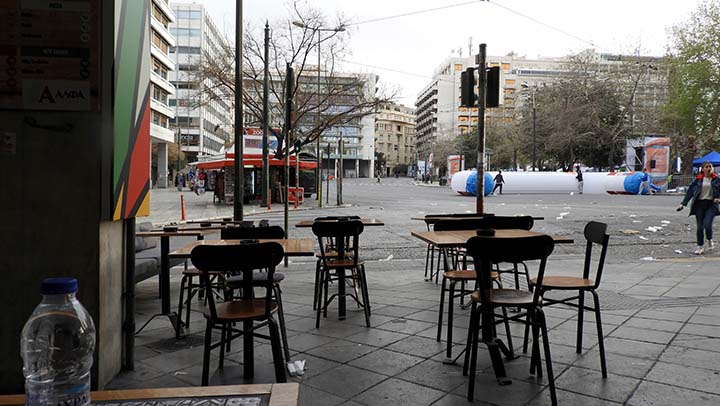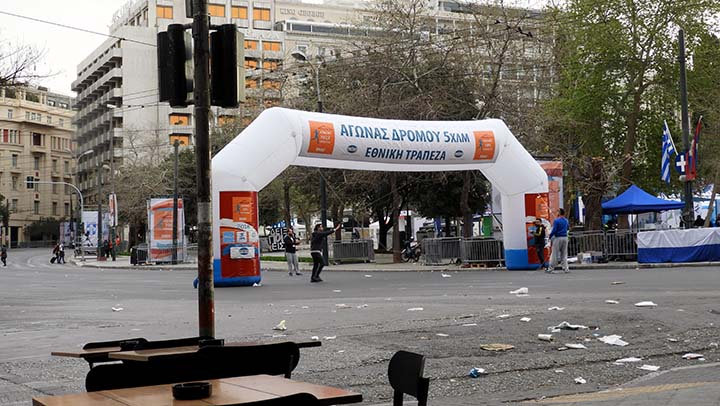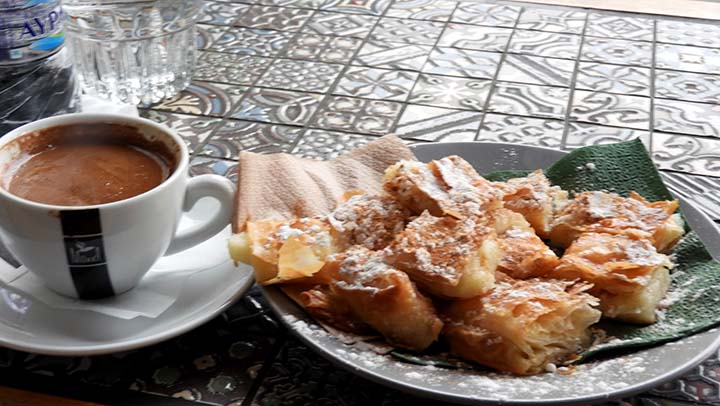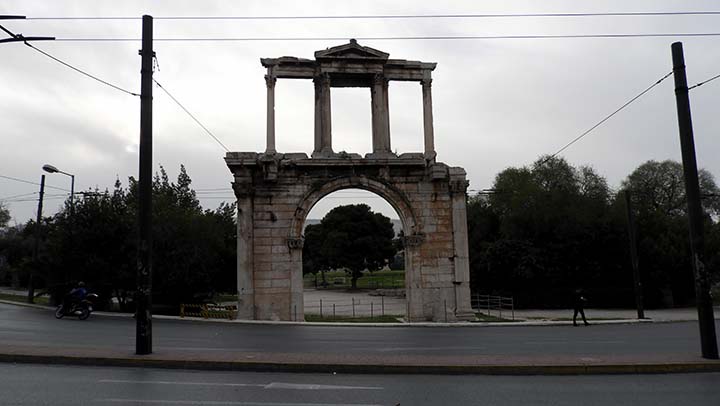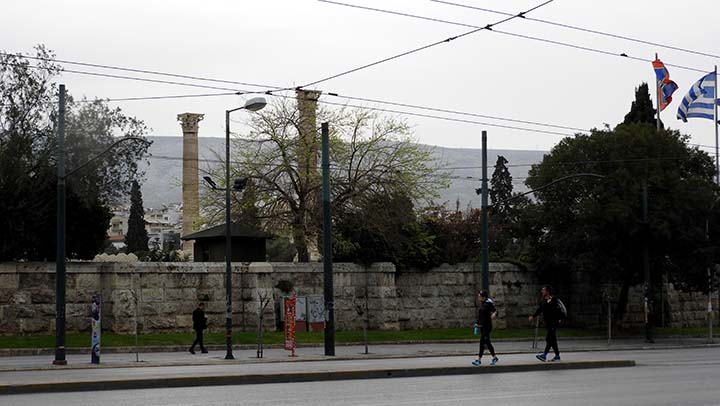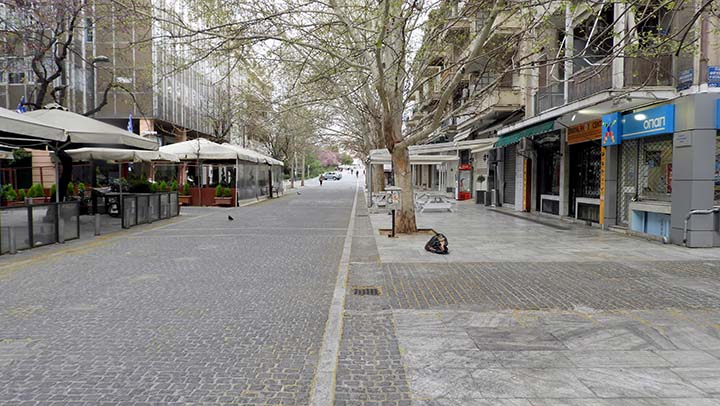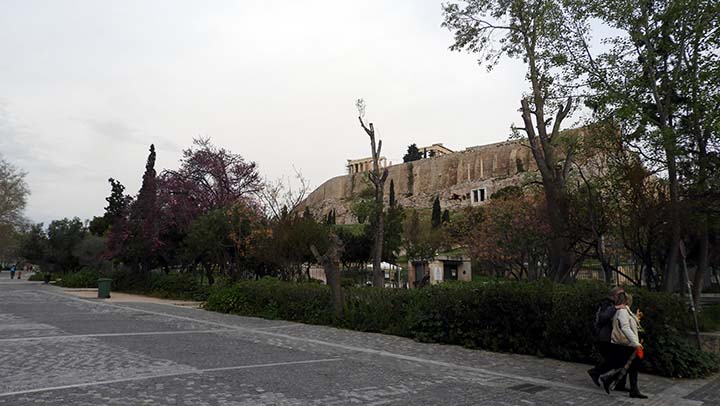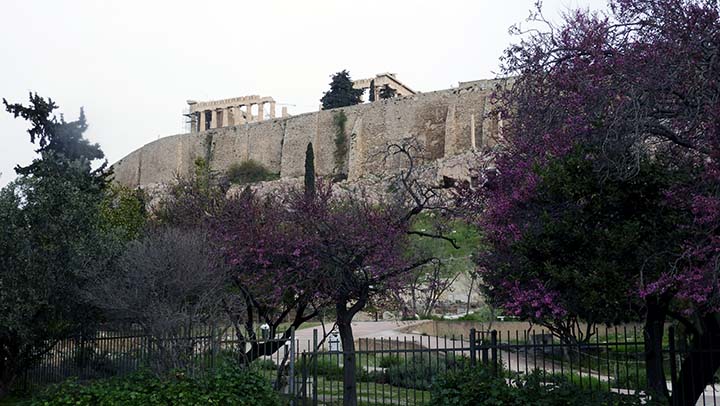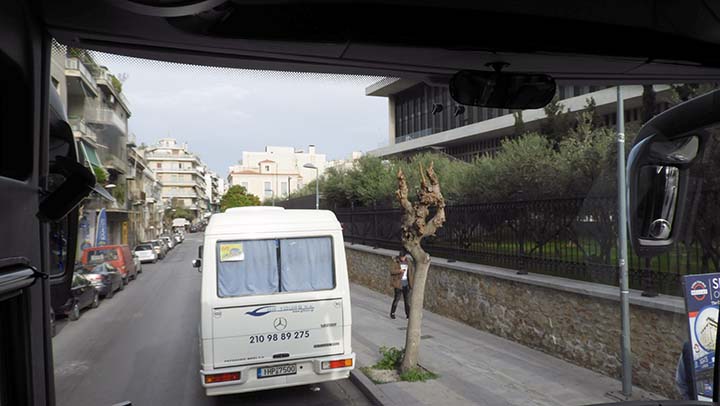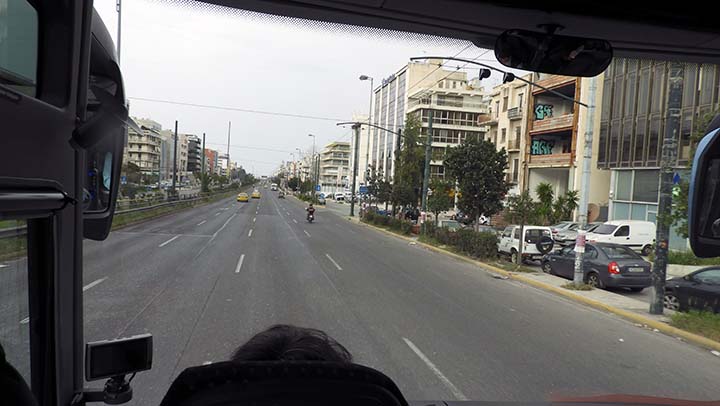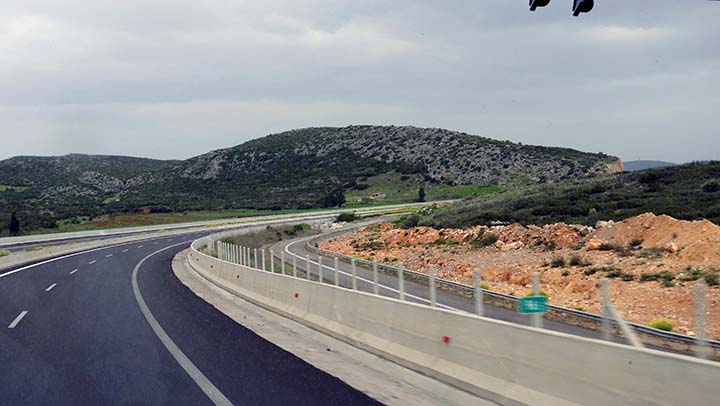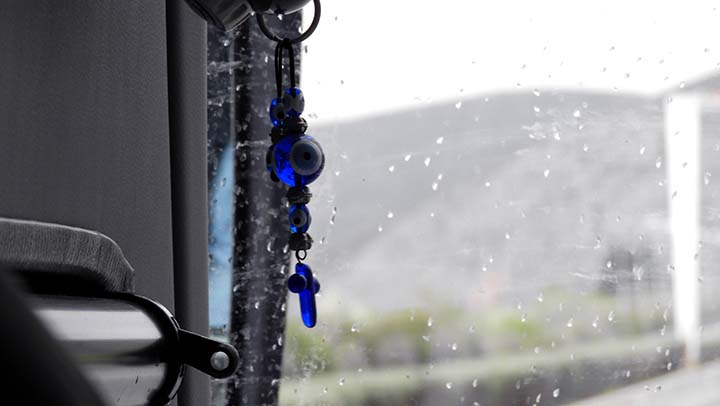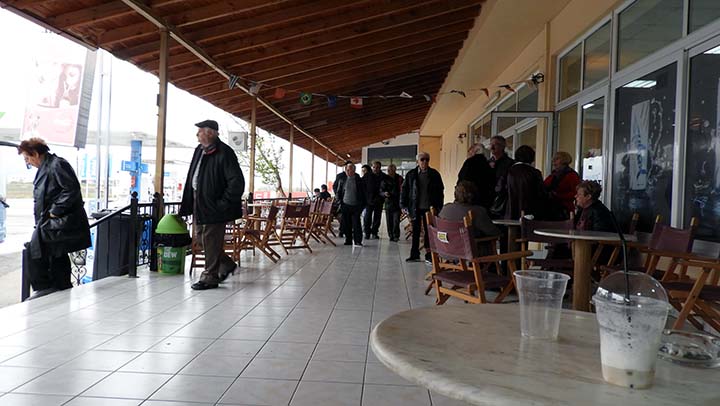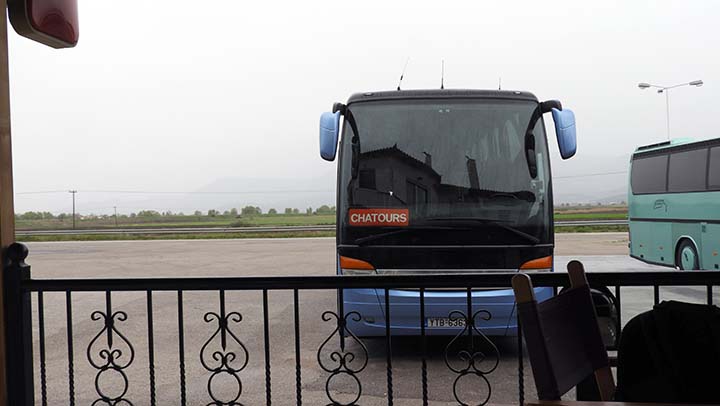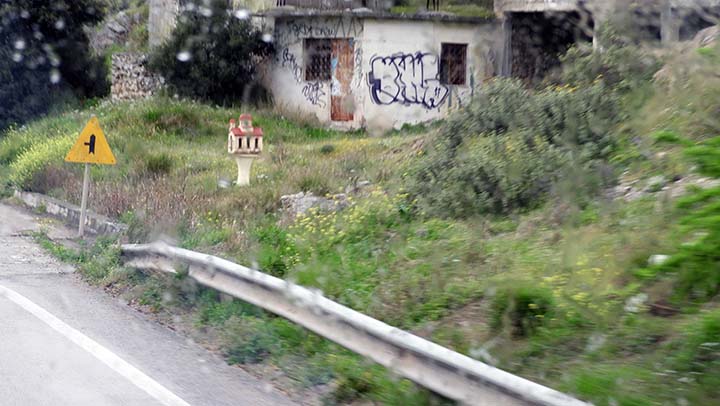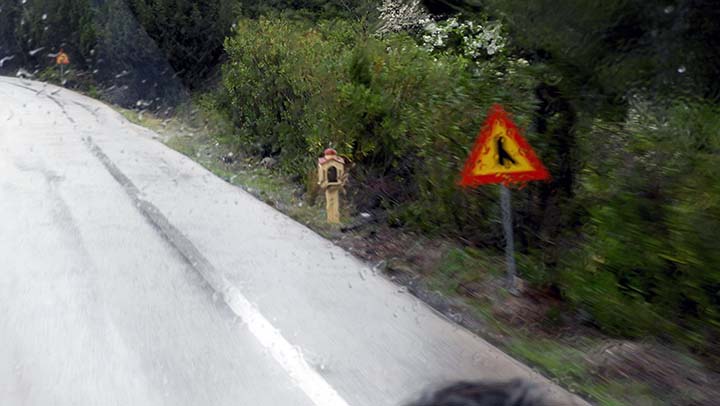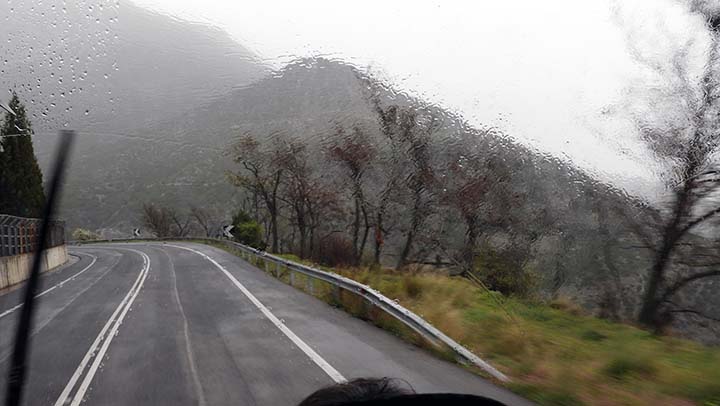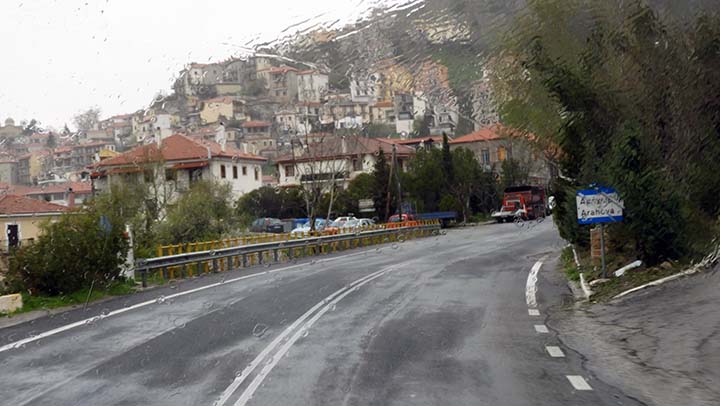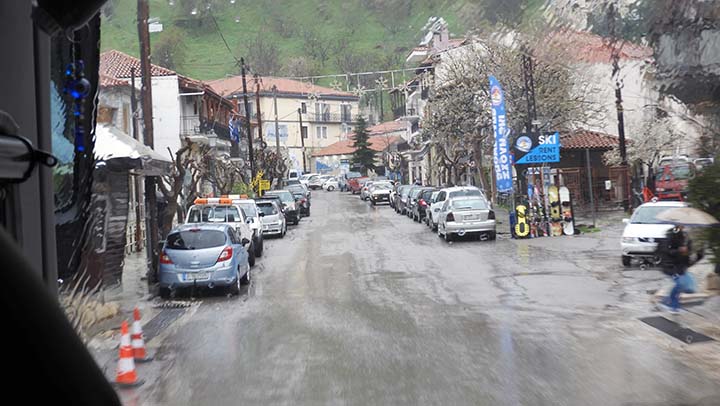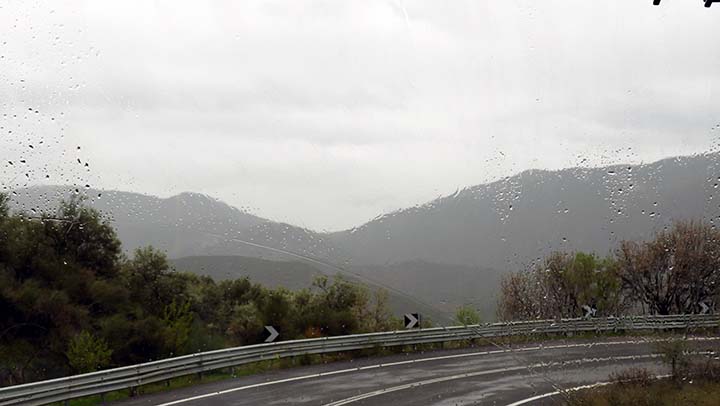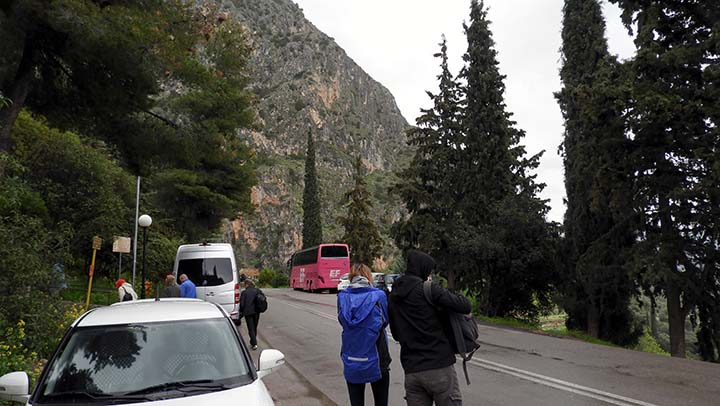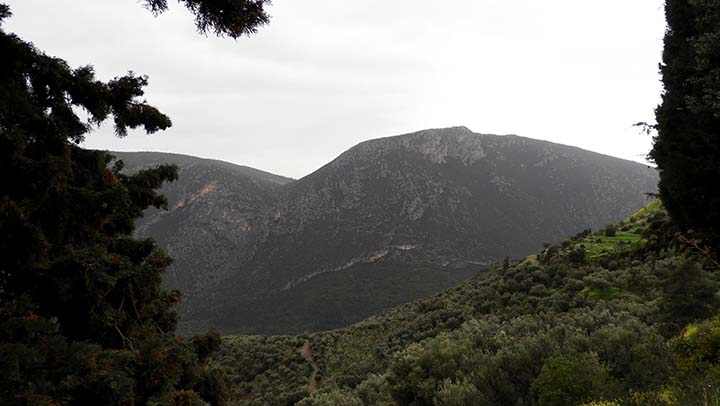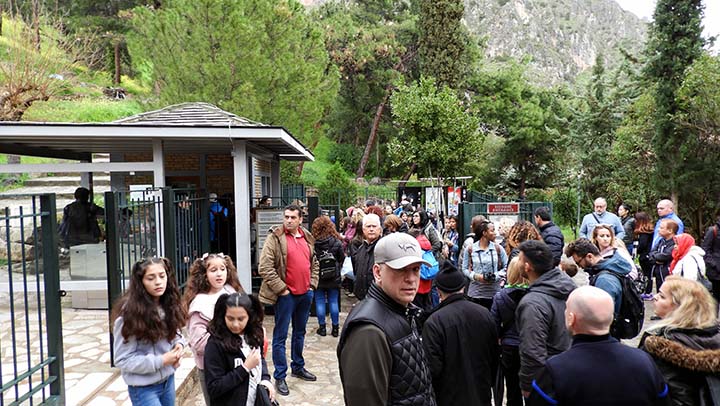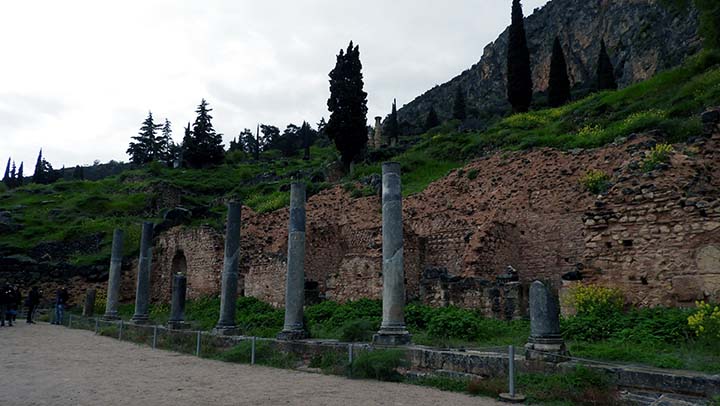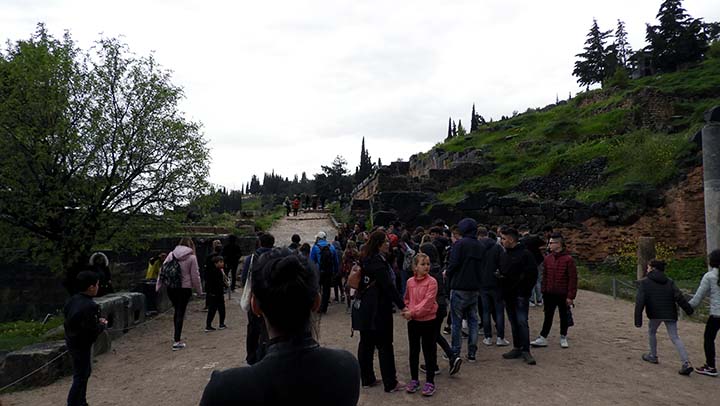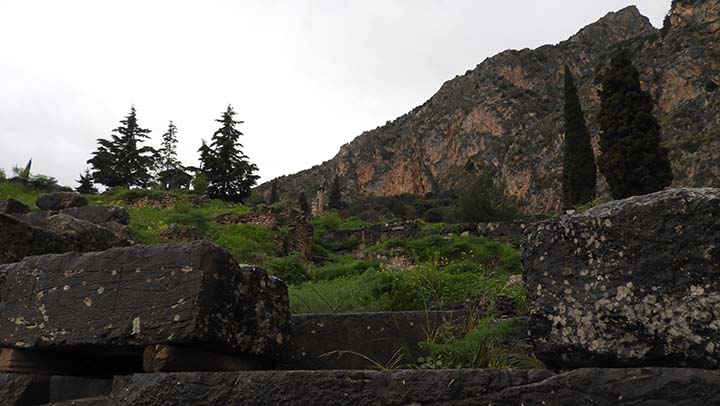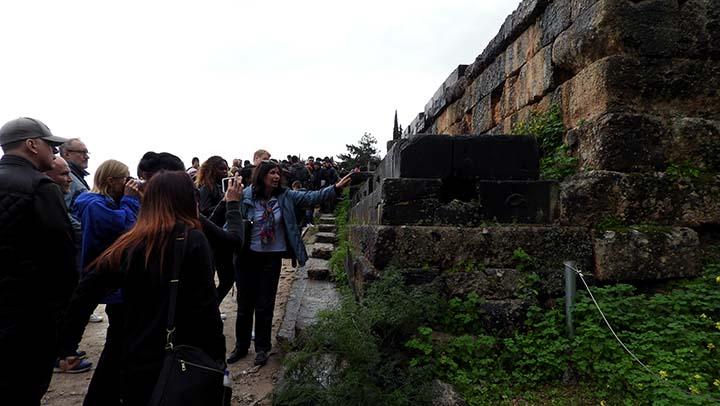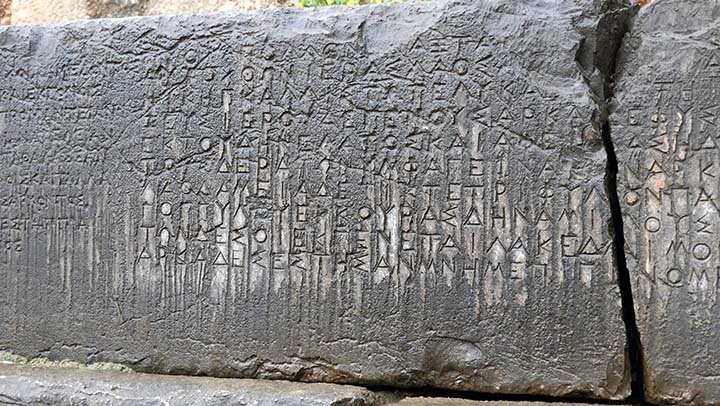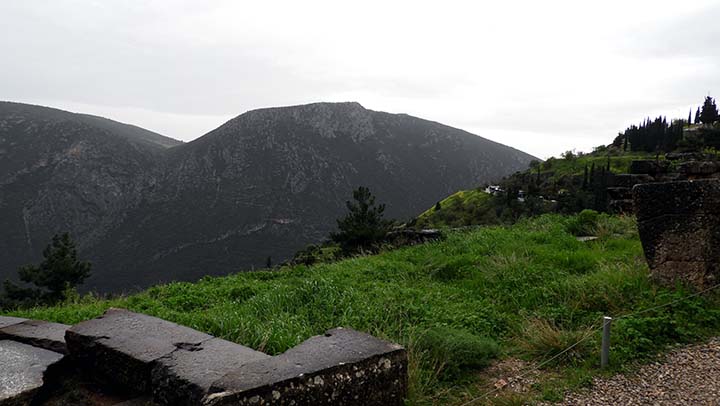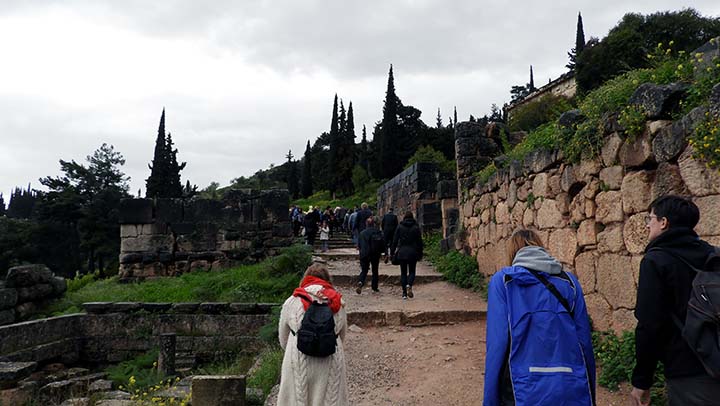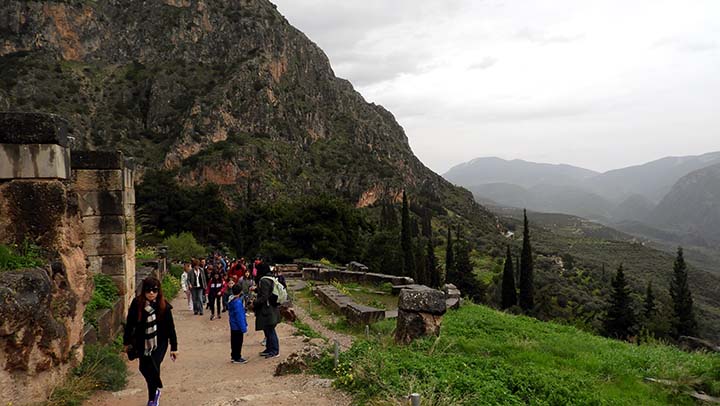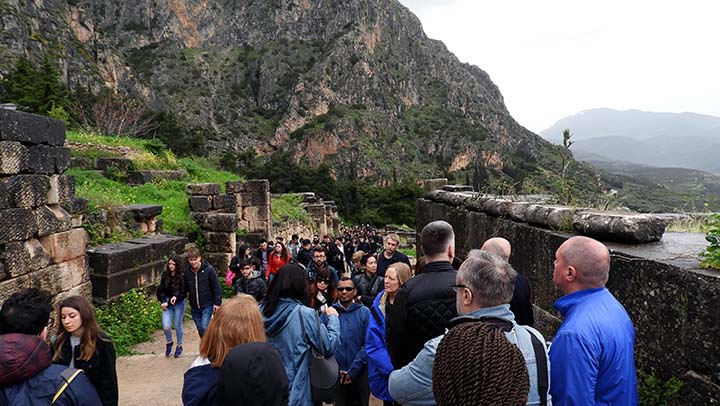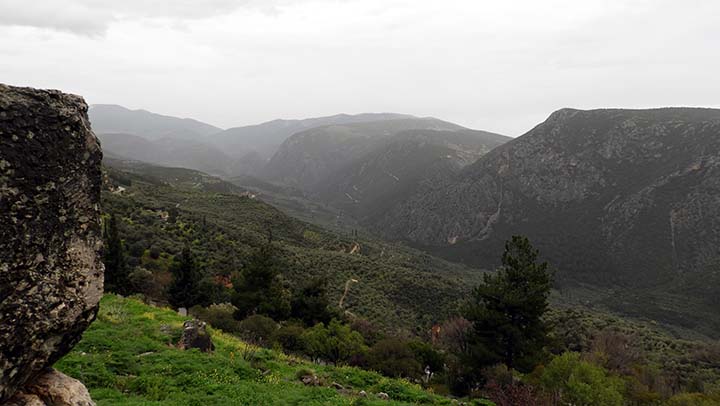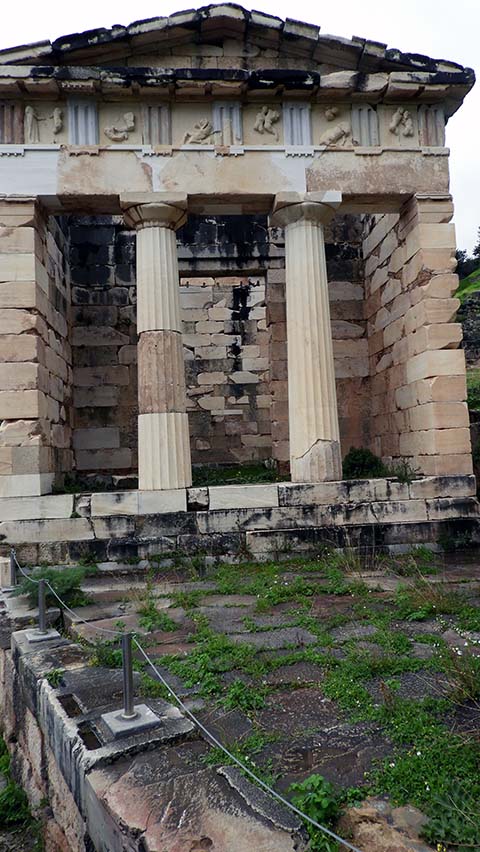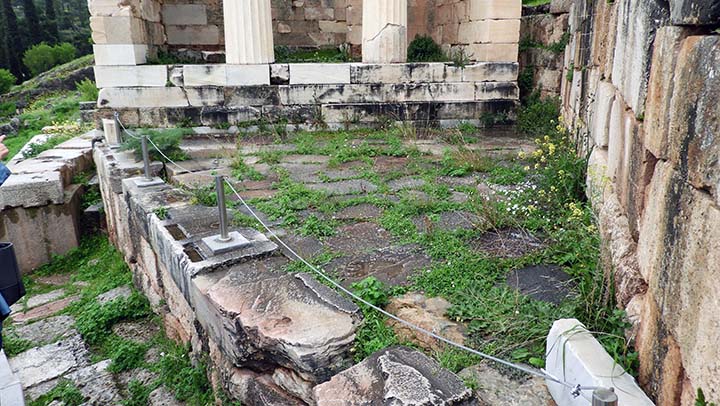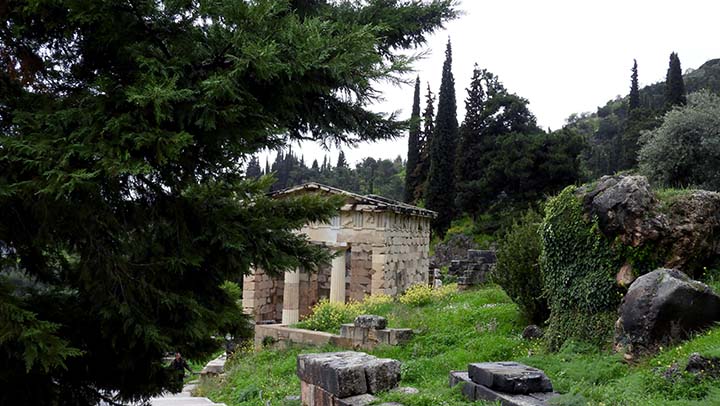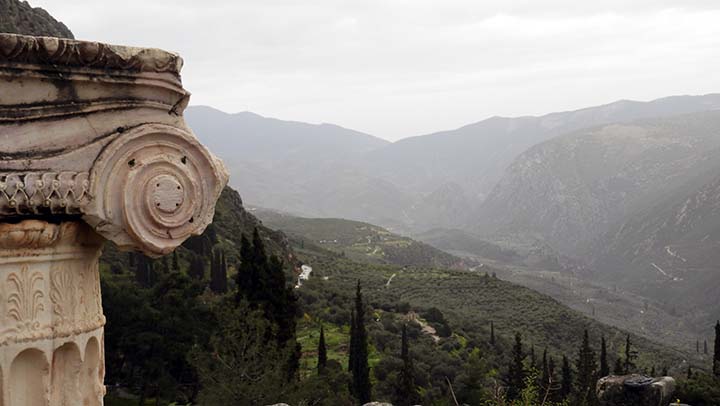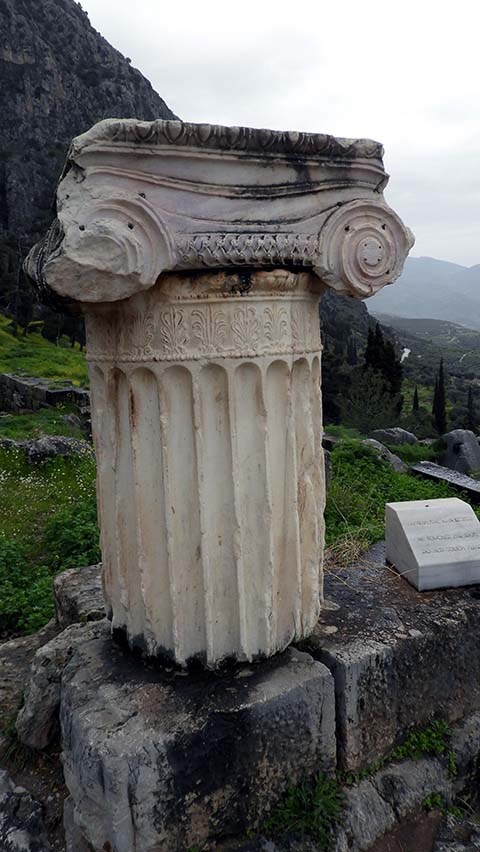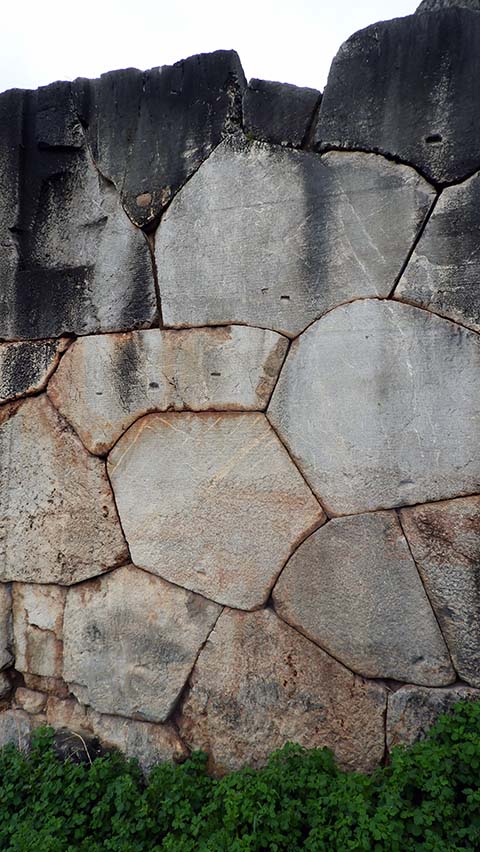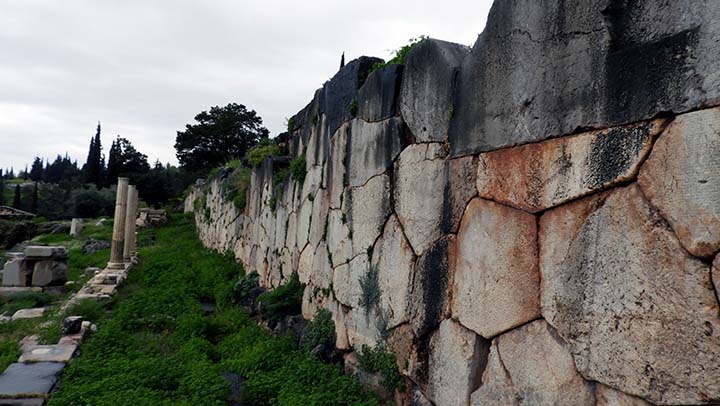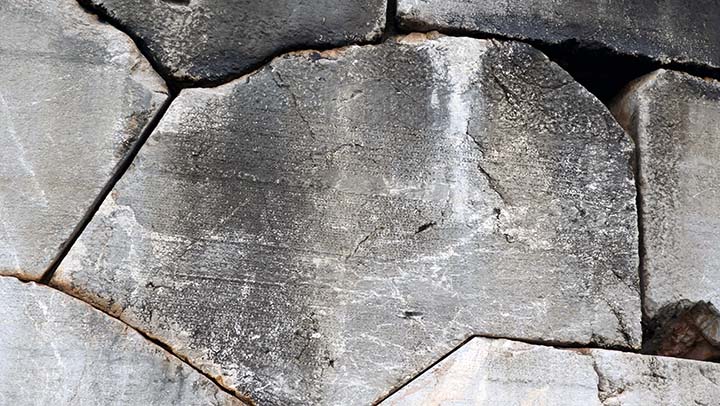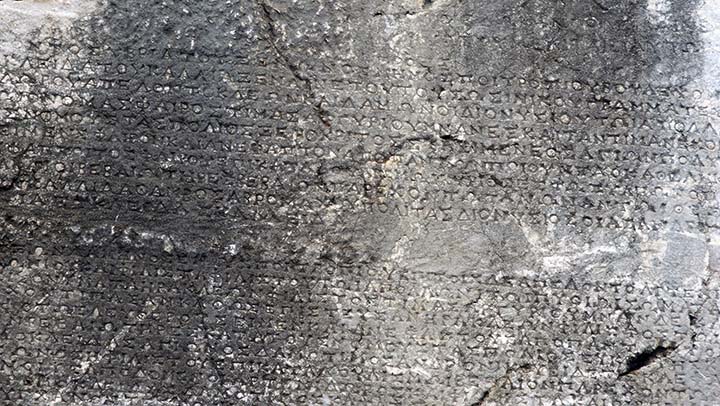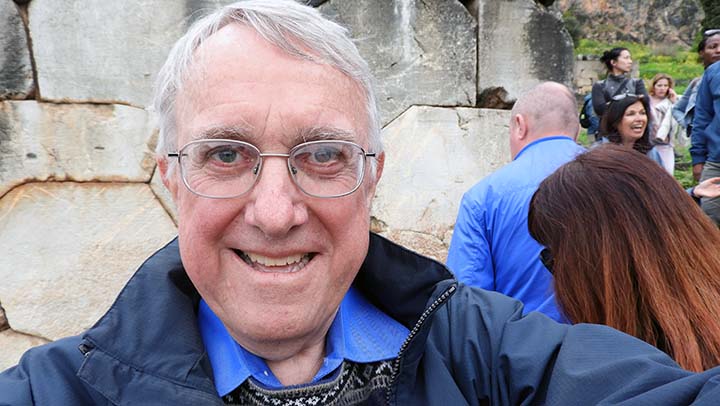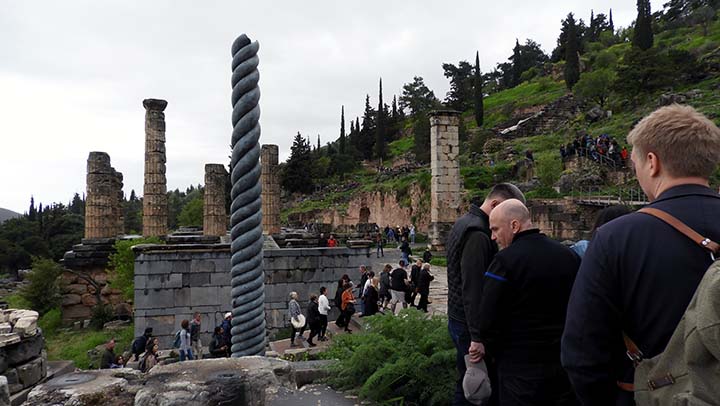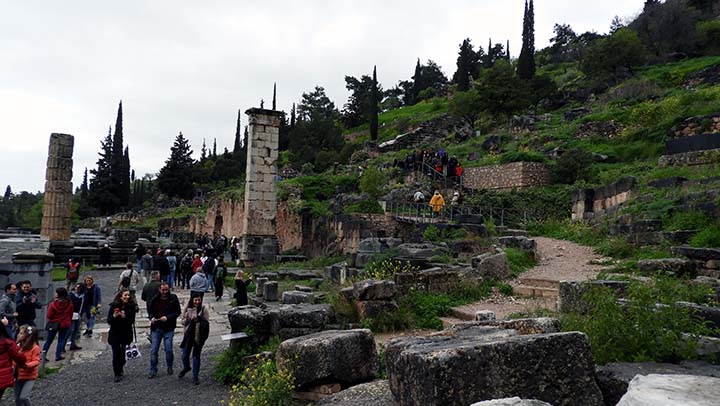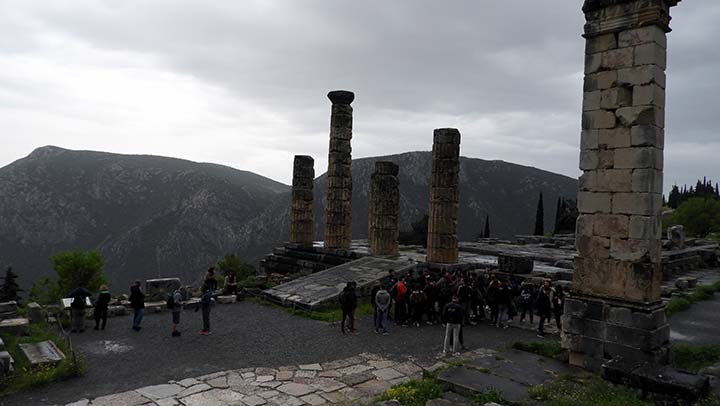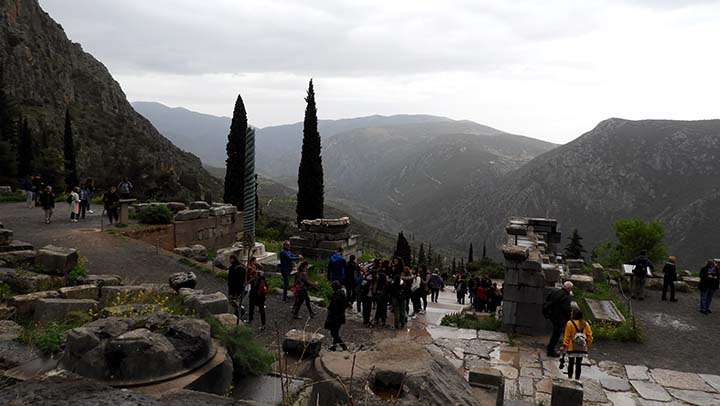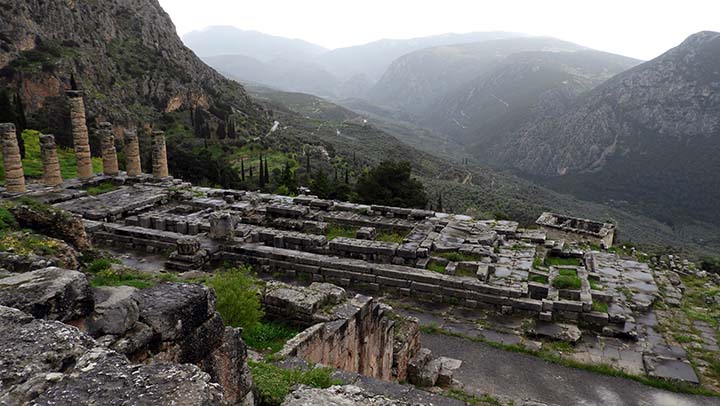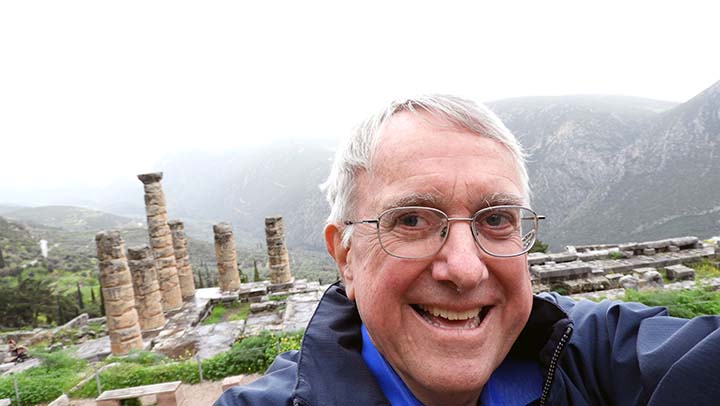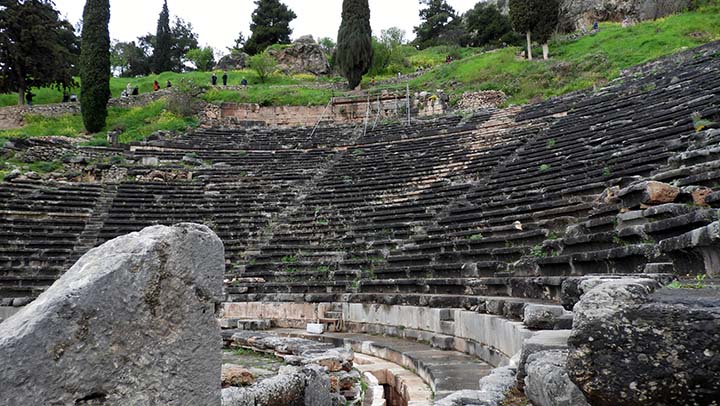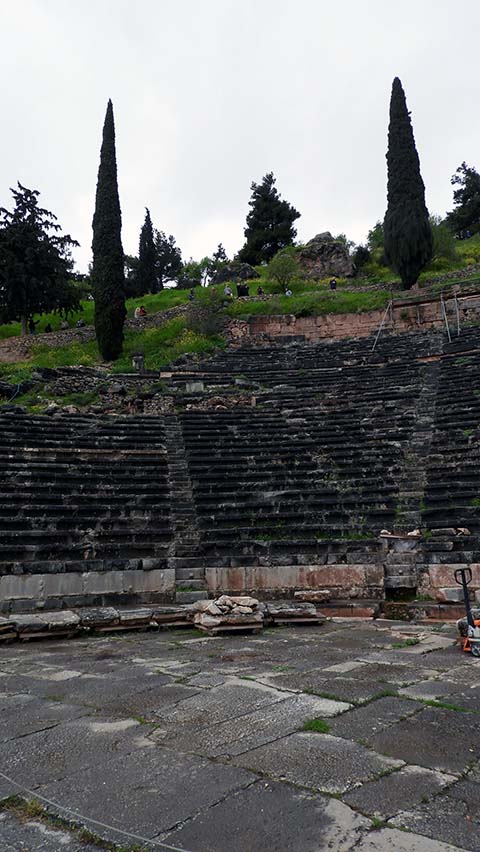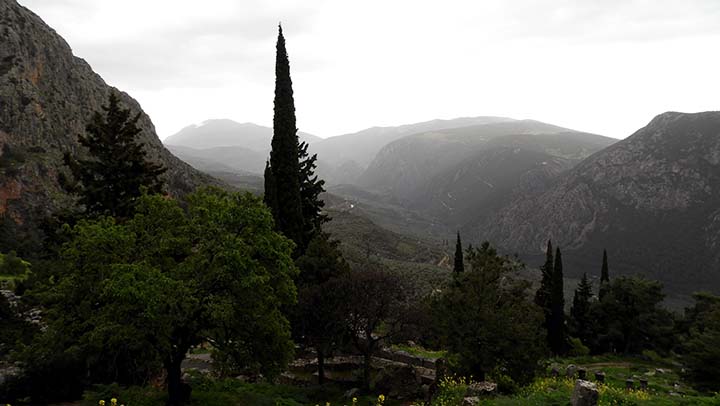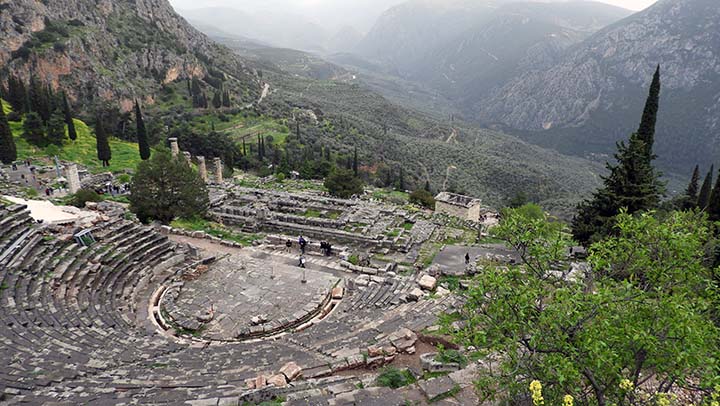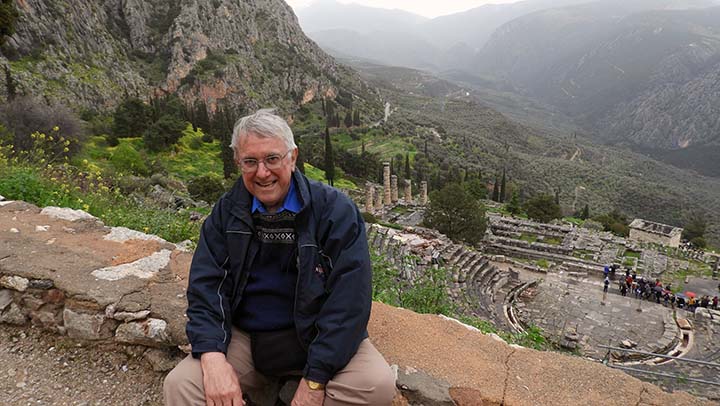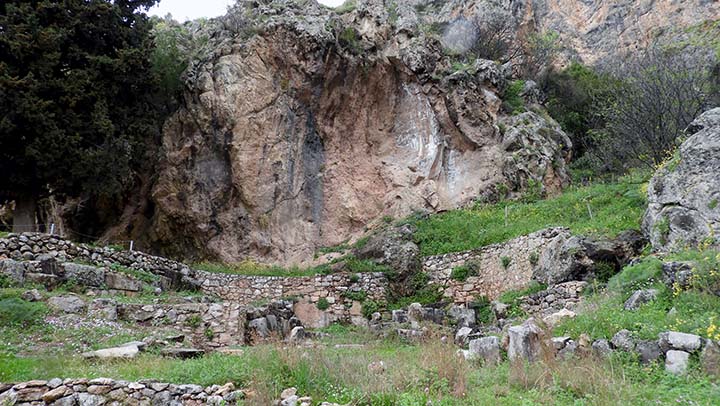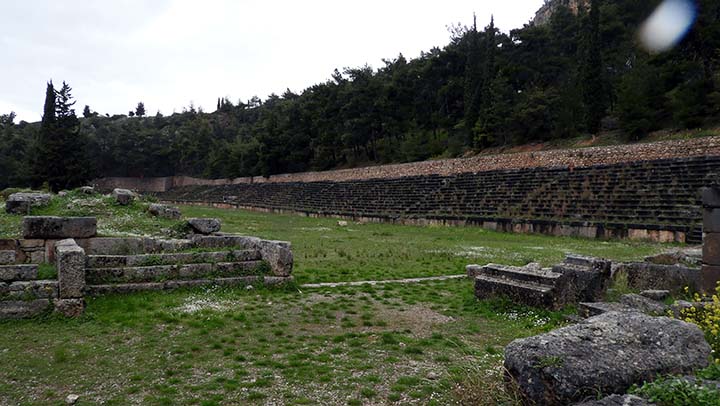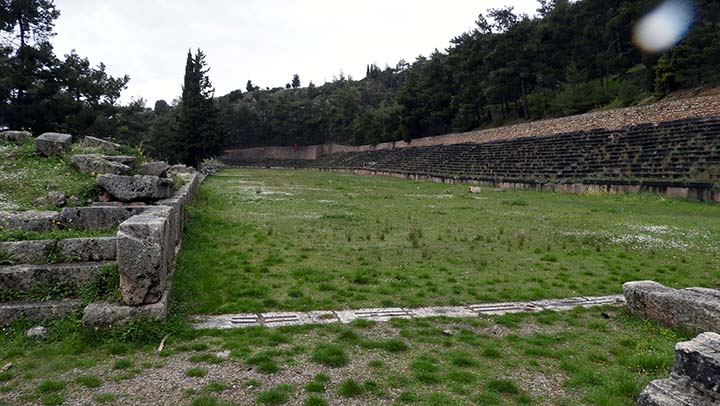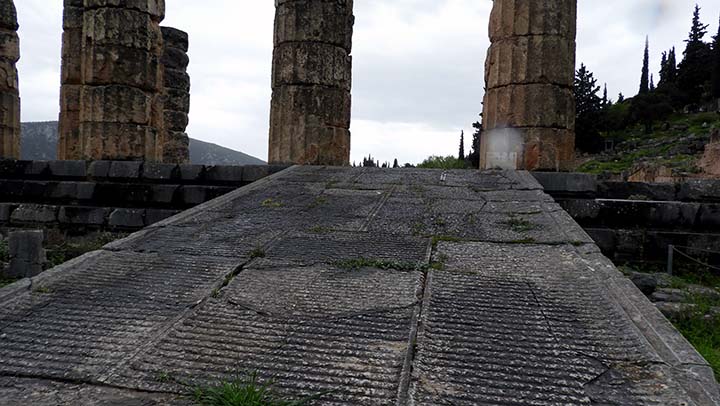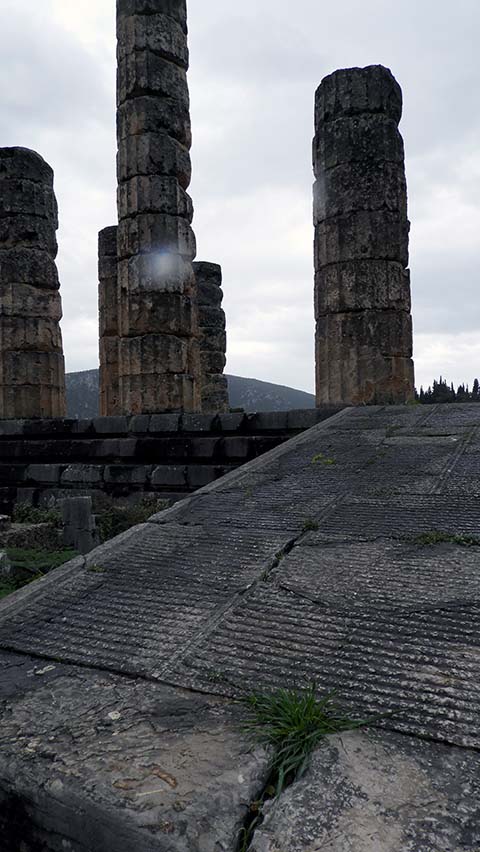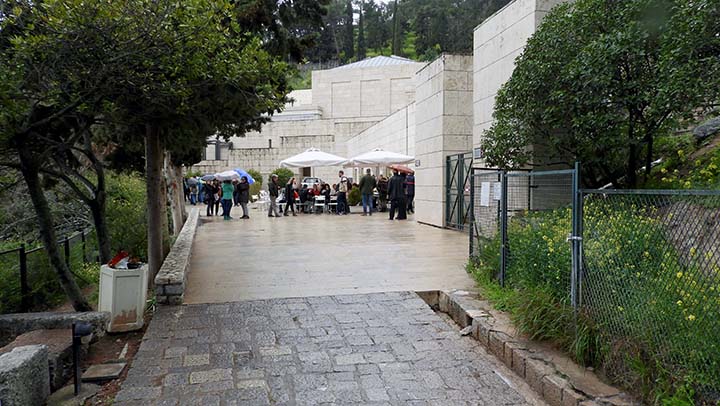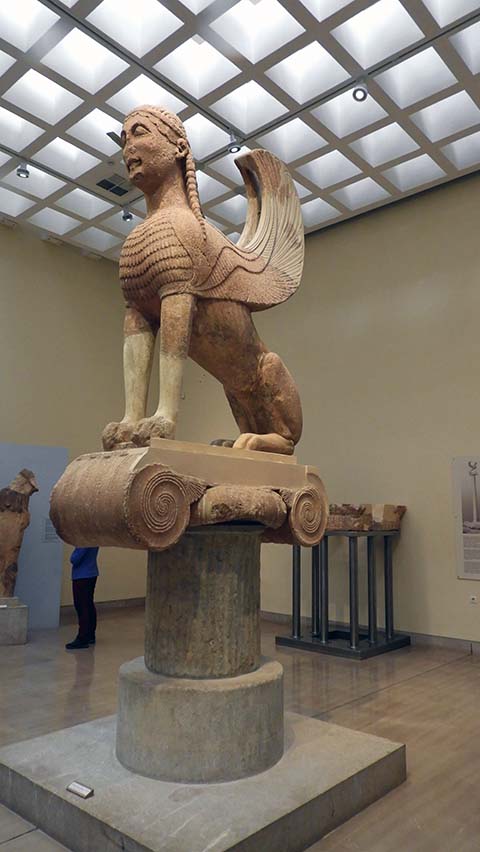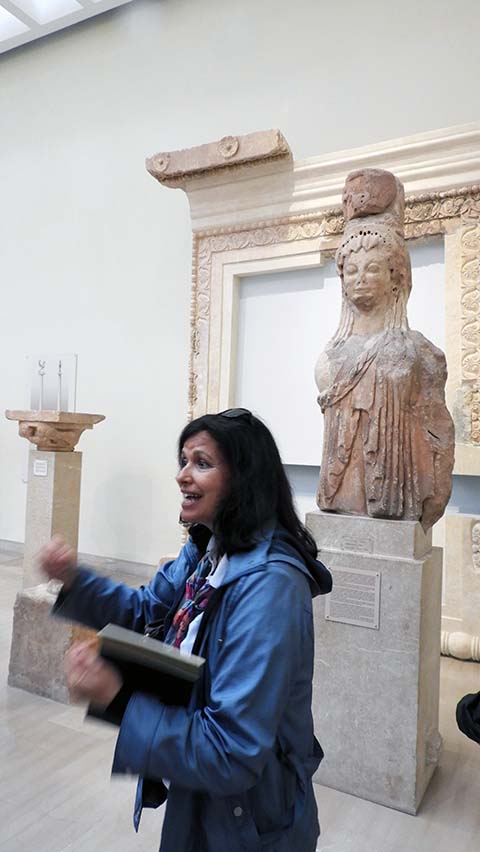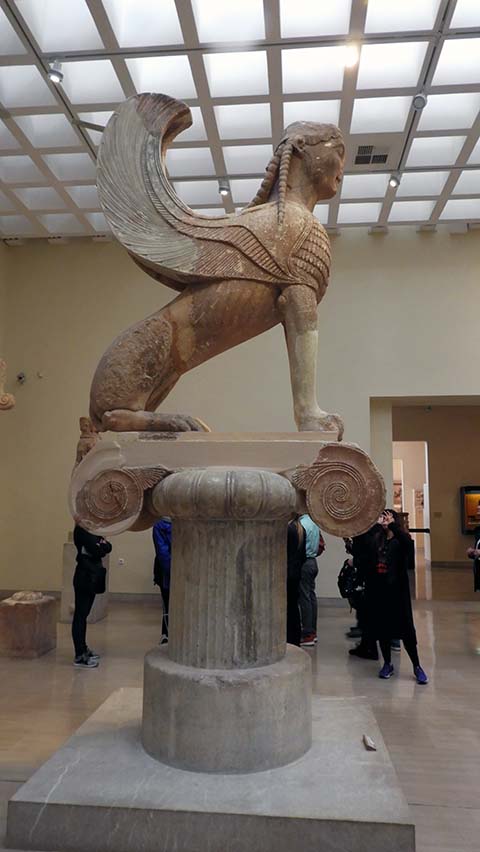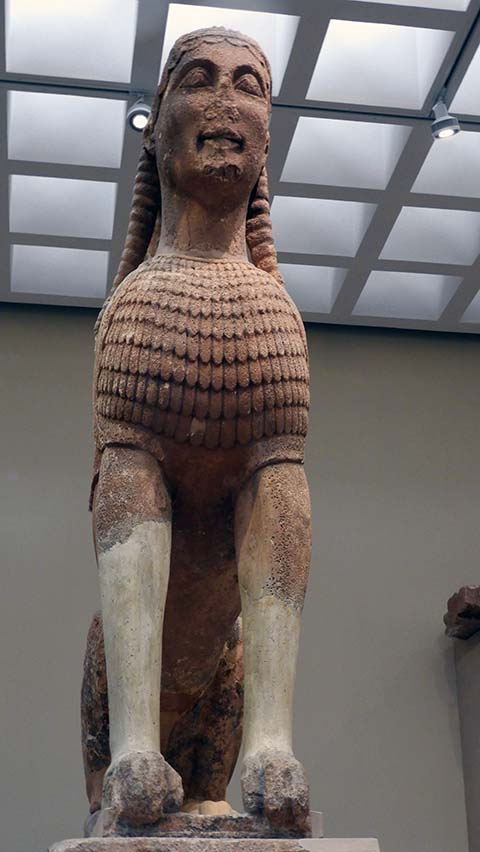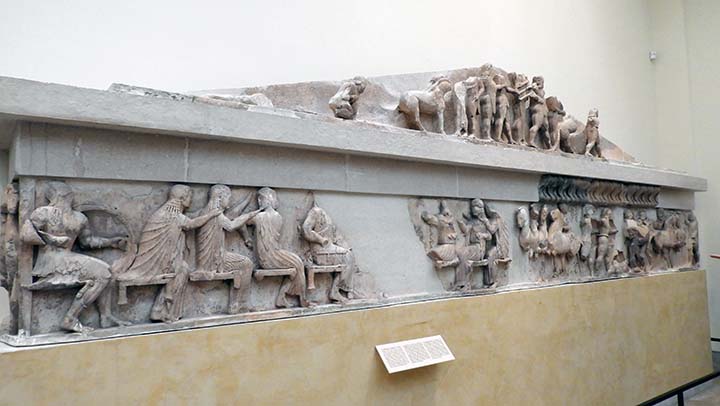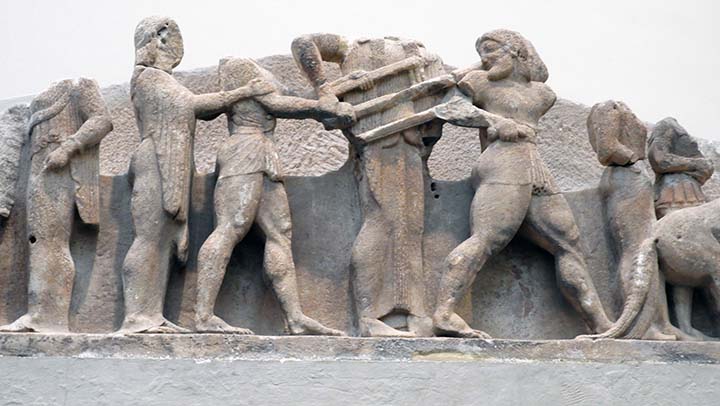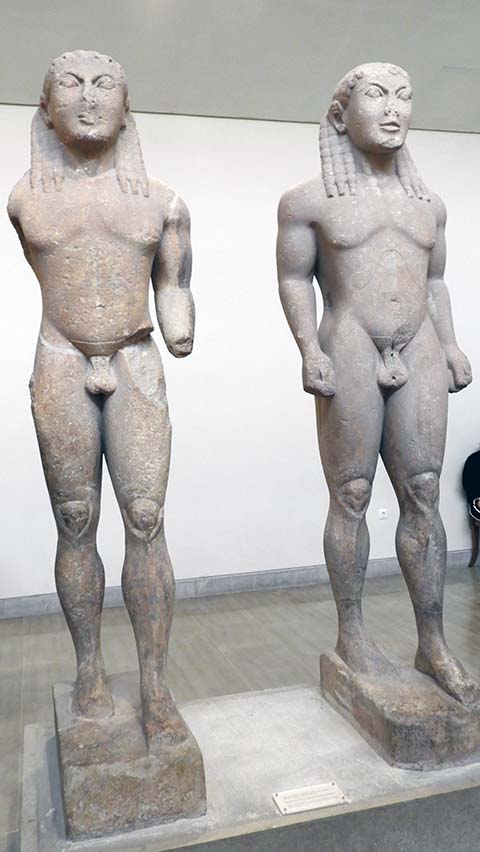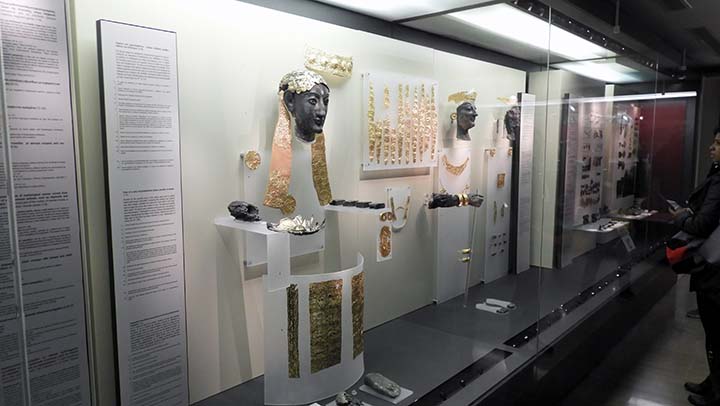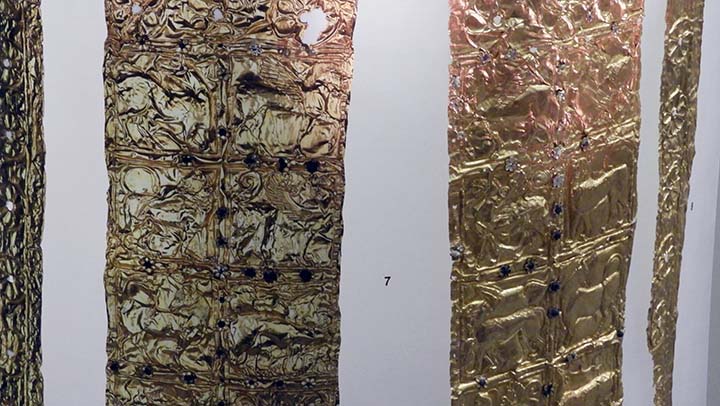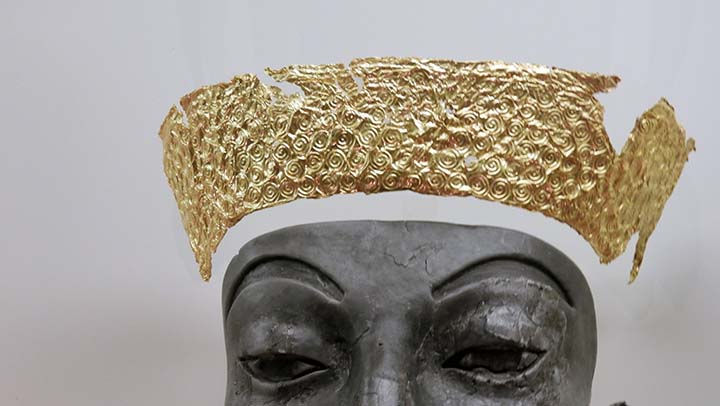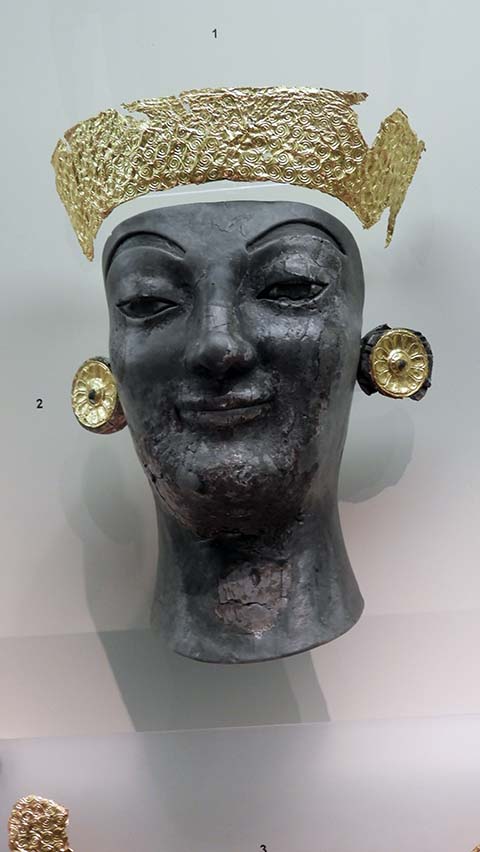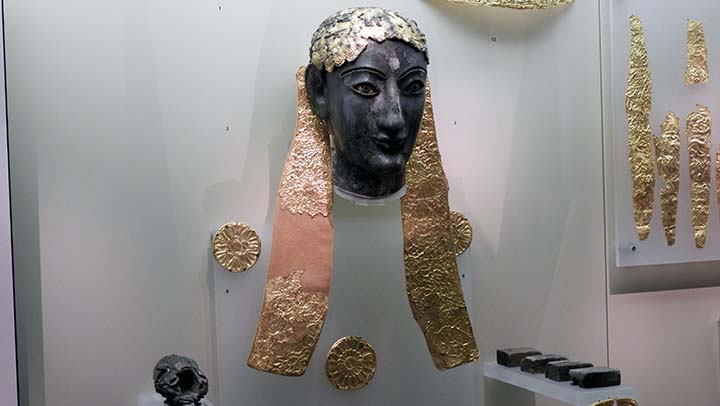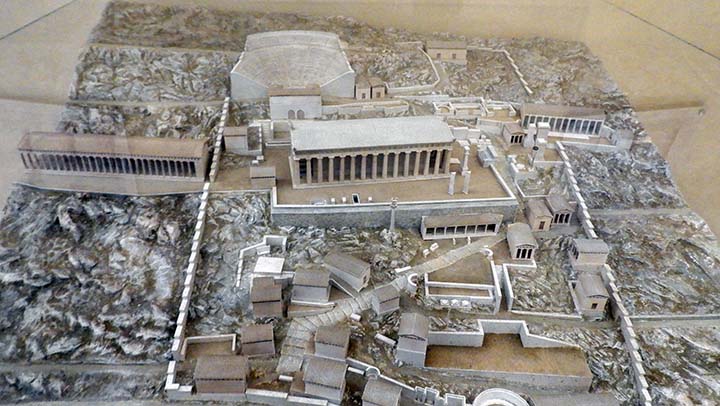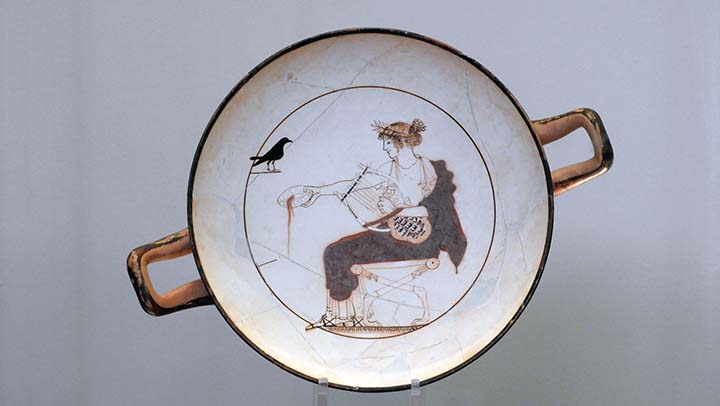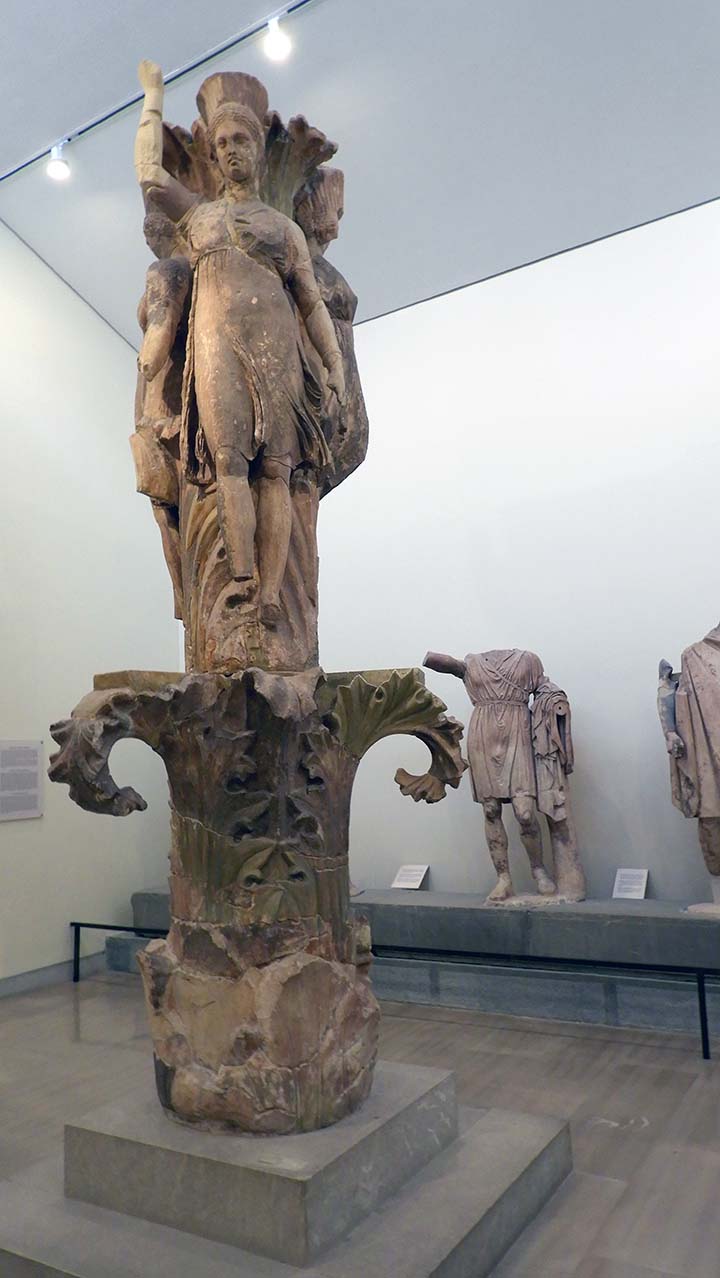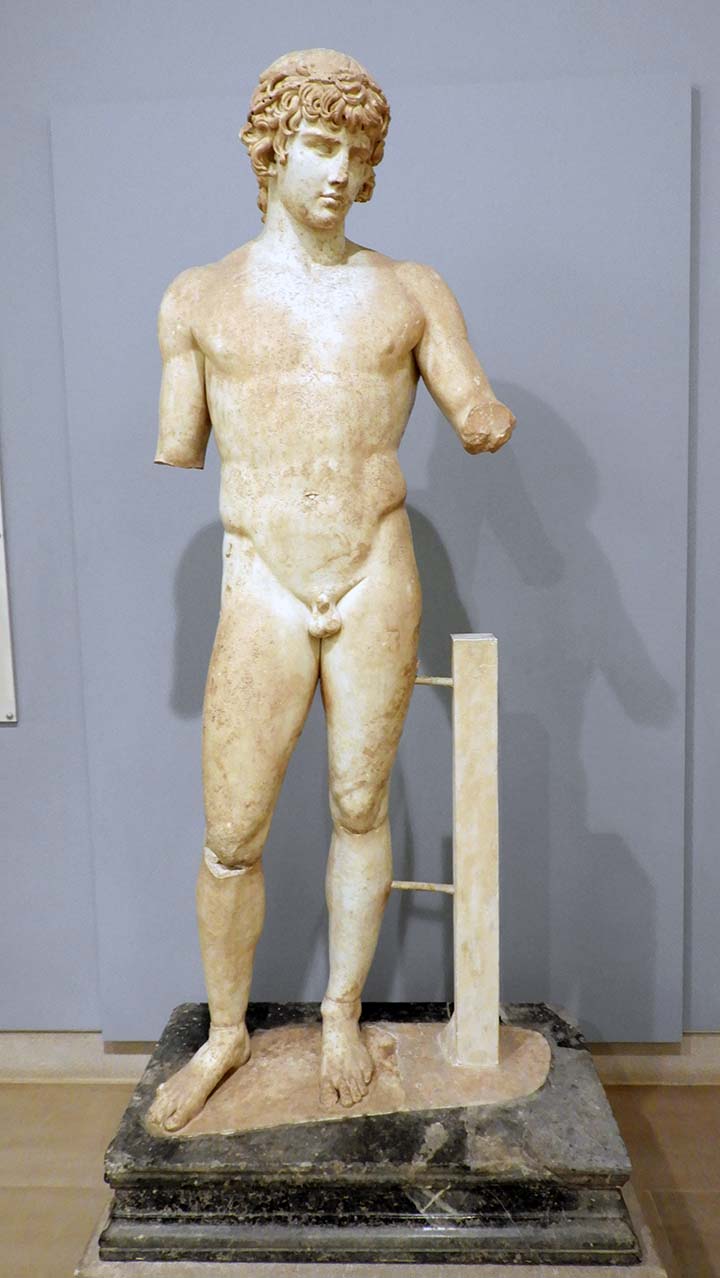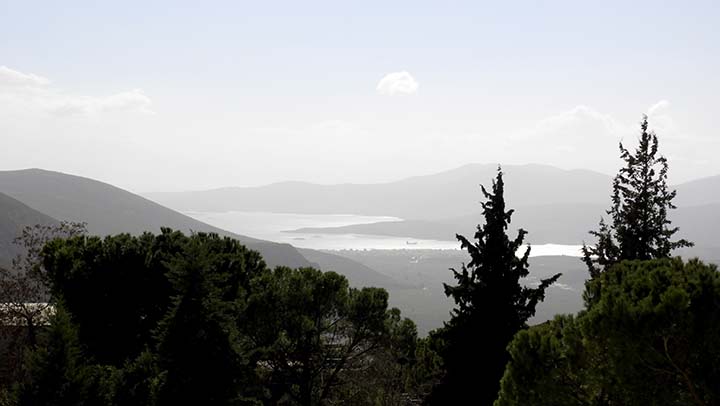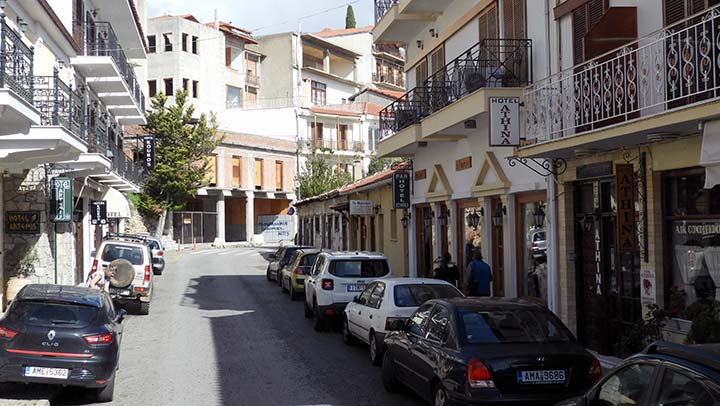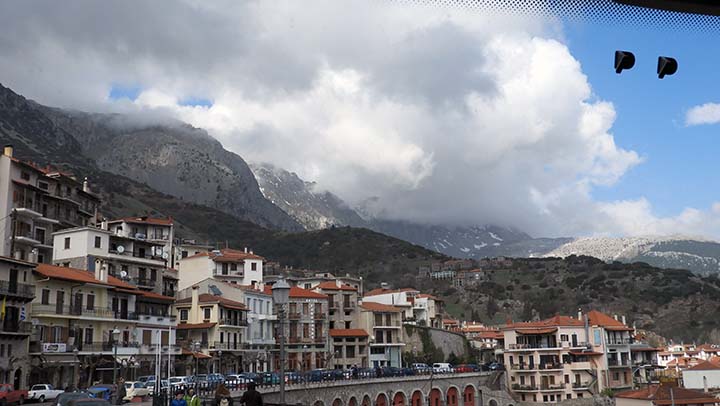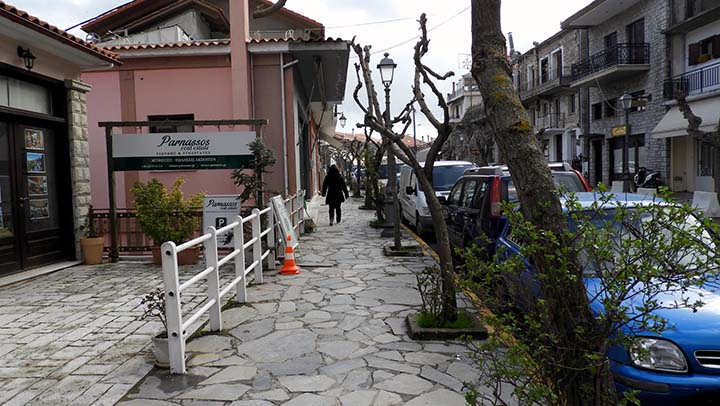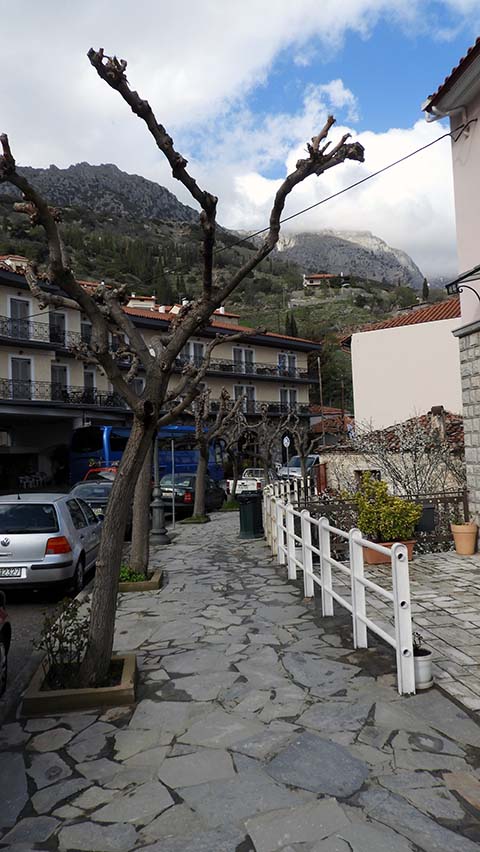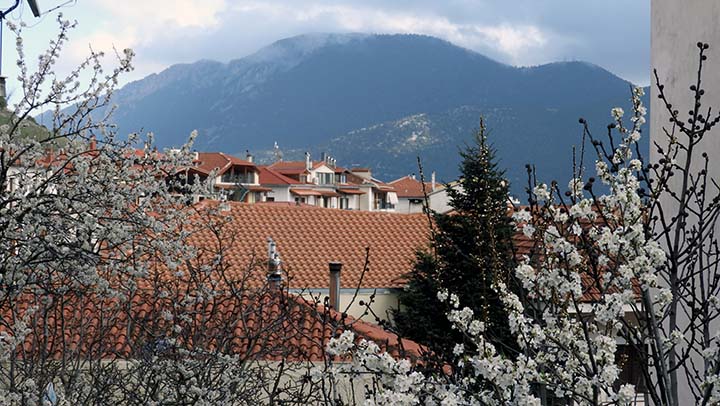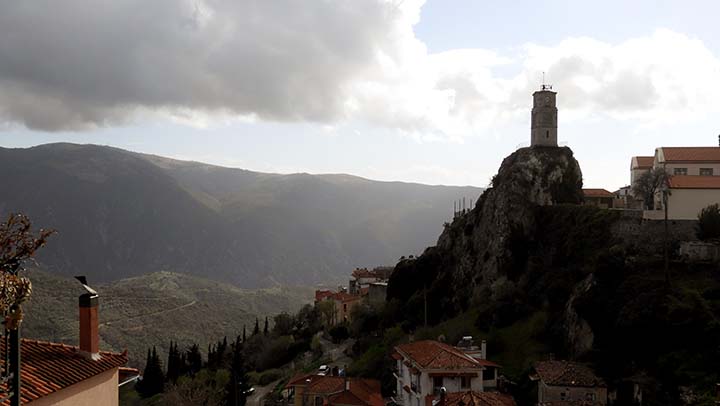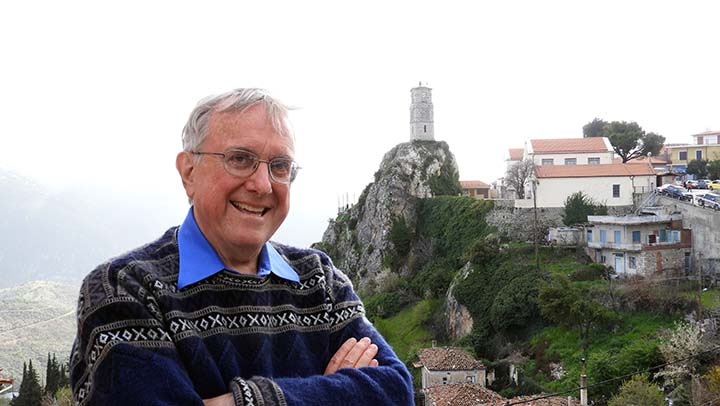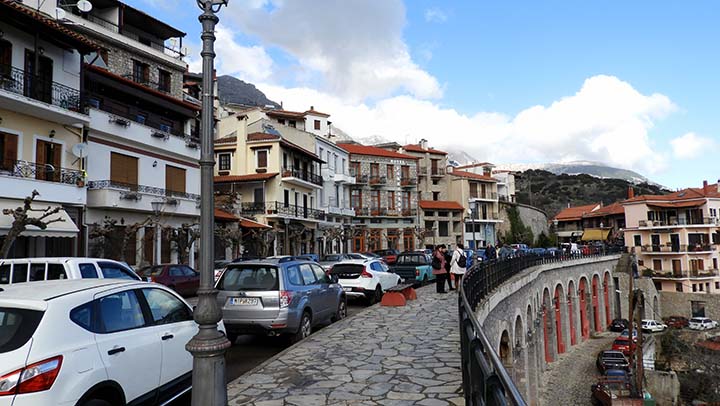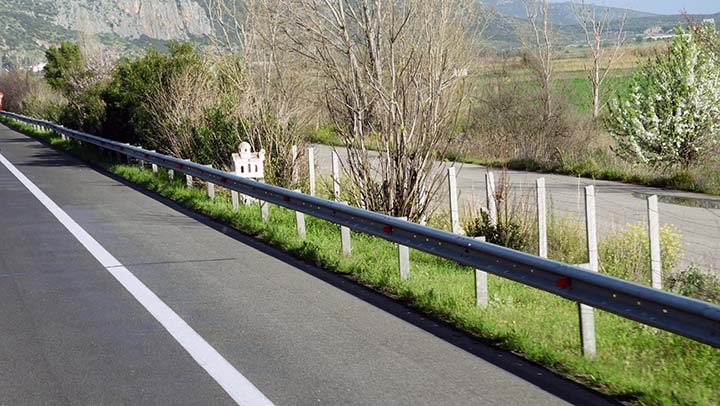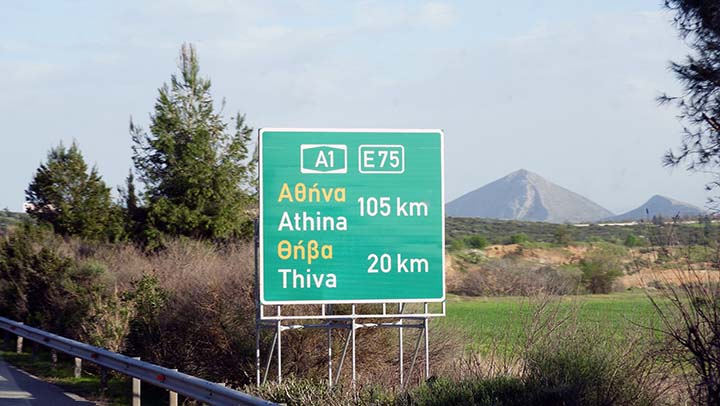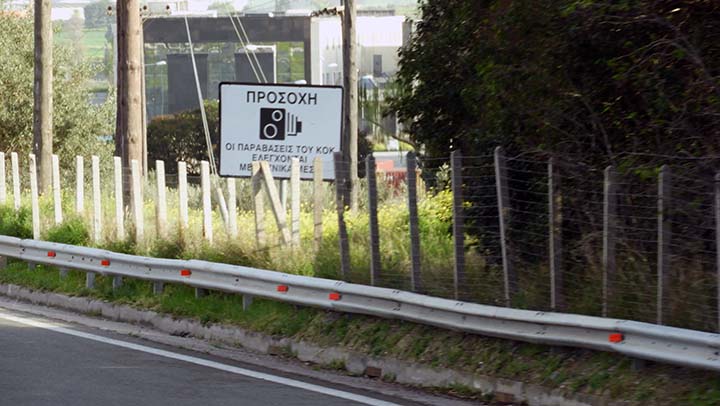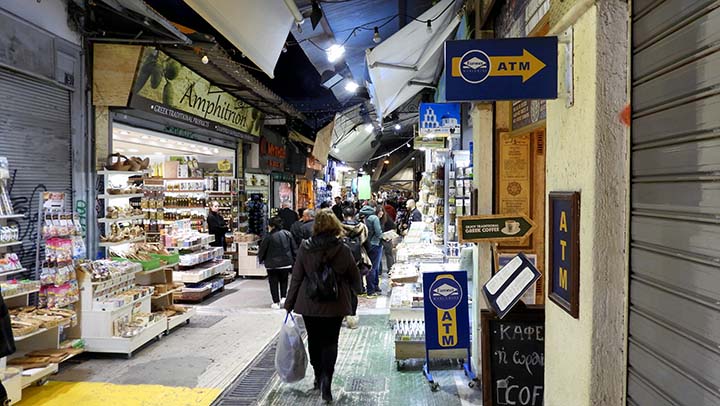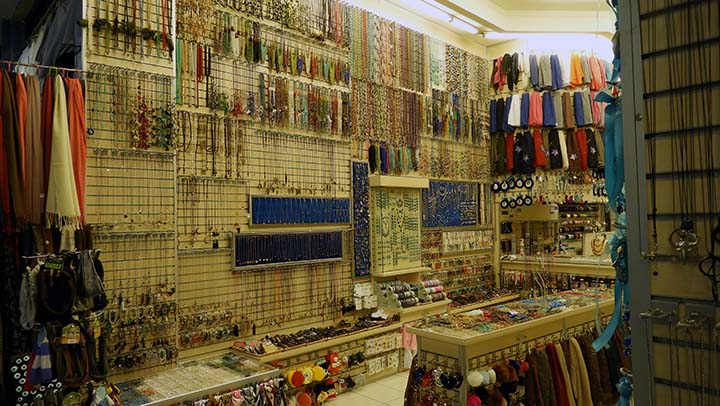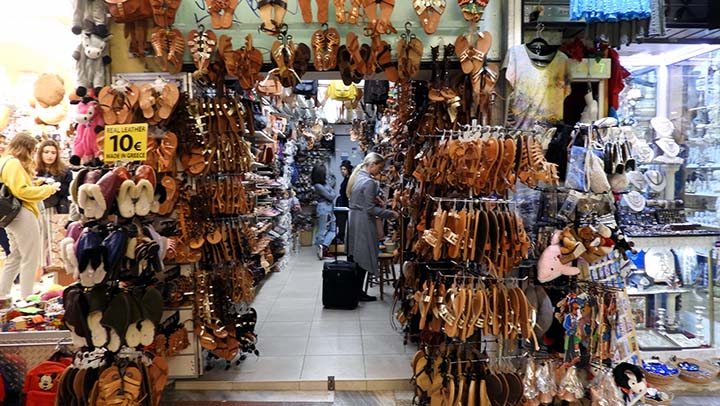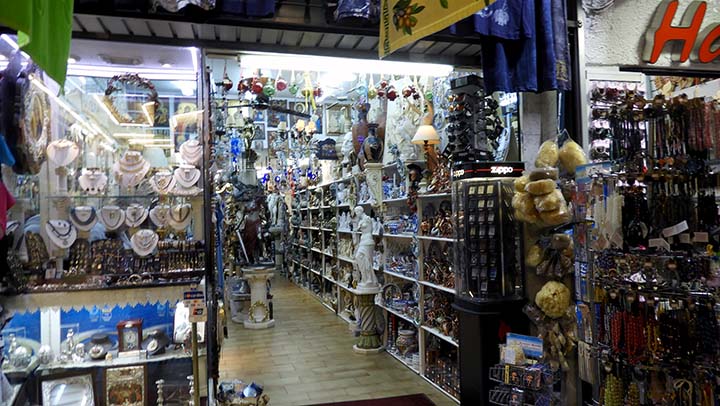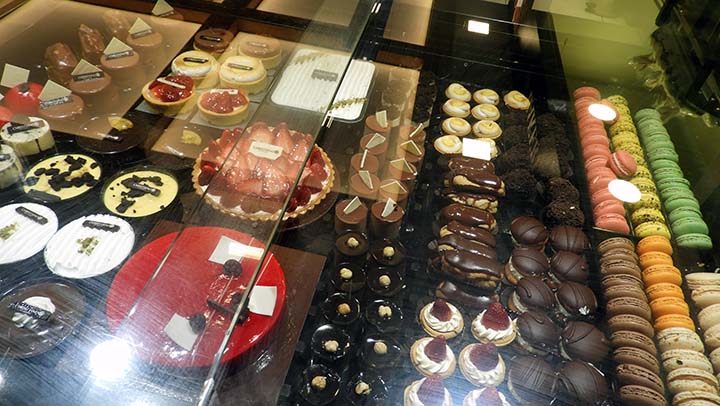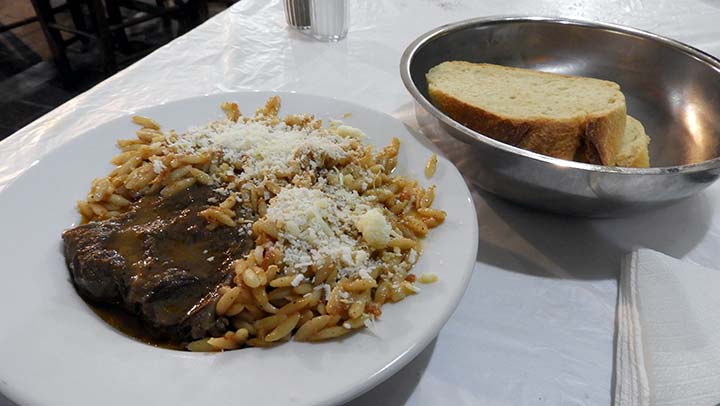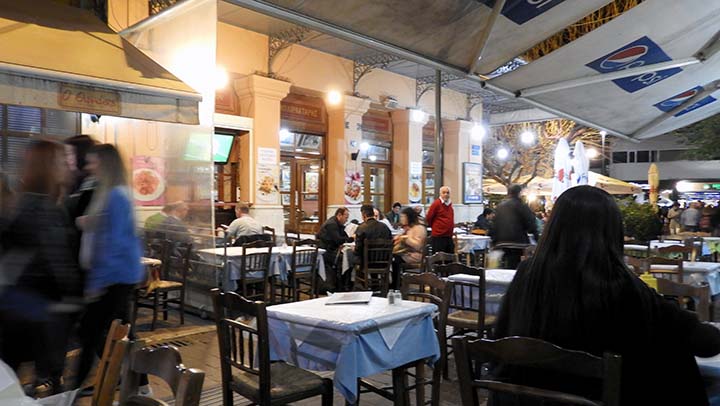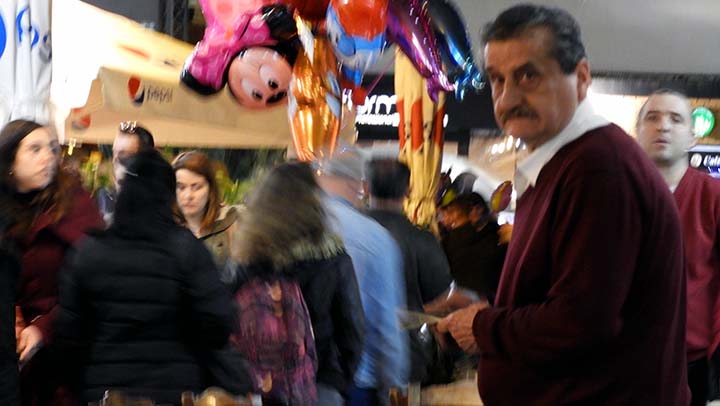|
OH NO! It's the final day of the trip! How could this have happened so soon? Guess Bill likes Greece.
Of course Bill stops again for some breakfast bugatsa before heading to the Hotel Amalia to meet the bus. Only...the bus won't be there today because of all the downtown road closures due to this morning's Athens Half Marathon. Is that great, or what? A Marathon! In Greece! But Bill's going to miss it.
He does enjoy watching them set up early in the morning.
And he really enjoys his final taste of bugatsa on the trip. With Greek coffee. You know, that stuff will put hair on your chest.
Bill stops by the Amalia Hotel and gets directions to the bus, which turns out to be parked on the back side of the Acropolis Archeological Museum. He's not going to wait to walk with the group because he's hoping he can get the front seat in the bus this morning. As he's walking along he passes the Temple of Zeus again.
But it's still behind that wall.
Downtown streets are blocked off and deserted. Soon they will be filled with runners and spectators.
Look up there! The Acropolis!
Bill never tires of gazing at the Acropolis of Athens.
Now he's on the bus -- and he scored the front seat for the day! Way to go, Bill! Now what's that peeking above the van right there by the pruned mulberry tree? Let's get out the telephoto lens...
Oranges! Can you imagine parking under an orange tree in downtown Athens? Bird droppings on your car would be bad enough, but orange droppings? That could dent something.
Now we're headed out of Athens on our way to Delphi to consult the Oracle.
It's turning into a dreary day, Bill's first bad weather of the trip.
But not to worry, the Chat Tours bus driver has an evil eye and a cross hanging above his head. We're in good hands, one way or the other.
Let's stop at some gigantic tourist Mecca for a comfort break. This place had maybe the biggest men's room I have ever seen. \
Our carriage awaits.
See that little church/shrine thingy?
They're by the road all over the place, they come in all shapes and sizes, and they're very difficult to photograph without blurring when your bus is barreling down the road. There are lamps and olive oil in them and people light them at night as memorials to lost loved ones. We were never out at night to see them lit up.
Uh, oh. We may find the Oracle under an umbrella.
Here's a nice, wet mountain town. Arachova. We'll come back in a little while, after we've seen the Oracle. Sure hope it'll stop raining.
Because it looks like a nice place to wander around in.
If it ever stops raining.
Which it seems isn't going to happen.
Wait a minute! We've arrived to see the Oracle, and the rain has stopped! It's a sign from her, I just know it is!
With the clouds lifting a bit, we can even see mountains over there across the valley.
So what are we going to see? Delphi occupies an impressive site on the south-western slope of Mount Parnassus, overlooking the coastal plain to the south and the valley of Phocis. It is now an extensive archaeological site with a modern town of the same name nearby. It is recognized by UNESCO as a World Heritage Site in having had a phenomenal influence in the ancient world, as evidenced by the rich monuments built there by most of the important ancient Greek city-states, demonstrating their fundamental Hellenic unity. And we may see an Oracle!
The Chat Tour lines up to see the Oracle.
Bill can't wait! I mean, it could start raining again any minute! Luckily he has a talisman -- that umbrella in his hand which he spent money on last night at some sort of "no-tax" store in Plaka. Wait, that's why it's not raining! You spend money on an umbrella and you can be assured it won't rain.
This plaza was built by the Romans. When you see red bricks you know the Romans did it. Well that's what Vicki the Chat Tours guide told us. But she's not Eleni, so I'm not sure I can trust her.
C'mon tourists, there's more uphill. As always.
In myths dating to the classical period of Ancient Greece (510-323 BC), Zeus determined the site of Delphi when he sought to find the centre of his "Grandmother Earth" (Gaia). He sent two eagles flying from the eastern and western extremities, and the path of the eagles crossed over Delphi where the omphalos, or navel of Gaia was found.
Here are some interesting stones.
There are inscriptions on them.
Turns out these are announcements of the manumission of slaves.
Pretty, even on a dreary day.
Let's go further uphill. Of course.
Keep up, tourists.
Wait, maybe not so many all at once! It's every high school student in Greece out on a Sunday field trip.
At least they get a pretty view.
So what's this?
It's the reconstructed Treasury of Athens, built to commemorate the Athenian victory at the Battle of Marathon.
It's believed that in this little courtyard the Athenians displayed treasures won at the Battle of Marathon.
Nice little place, the Athenian Treasury, even if it is reconstructed out of odds and ends.
Now that is an ionic capital.
On a little stub of a column. They do have lots of odds and ends lying around here.
Kinda amazing how they fit these stones together to form the wall.
And there are inscriptions on the faces of the stones.
More about the manumission of slaves.
I hereby grant freedom to my faithful slave Yanni for standing true by my side at the Battle of Marathon. Or something like that.
Selfie time!
That twisted column is just a copy of the original, now on display in Istanbul. It's supposed to be snakes intertwined, but the heads up top are missing, so somebody decided the heads on this copy should be missing too. Here's what my website from that trip has to say: The heads of the three serpents were knocked off in the 18th century by a drunken Polish nobleman. One of them can be seen in the Istanbul Archeological Museum, one's at the British Museum in London, and the third one is forever lost, apparently.
Onward and upward!
Now this is the actual Temple of Apollo at Delphi, the place where the Oracle made her predictions. That ramp led into the main chamber.
If you'd like to know all about the Oracle, or Pythia as she was called, click here.
But for now, you can just read this: Dating back to 1400 BC, the Oracle of Delphi was the most important shrine in all Greece, and in theory all Greeks respected its independence. Built around a sacred spring, Delphi was considered to be the omphalos - the center (literally navel) of the world. People came from all over Greece and beyond to have their questions about the future answered by the Pythia, the priestess of Apollo. And her answers, usually cryptic, could determine the course of everything from when a farmer planted his seedlings, to when an empire declared war. Arguments over the correct interpretation of an oracle were common, but the oracle was always happy to give another prophecy if more gold was provided. A good example is the famous incident before the Battle of Salamis when the Pythia first predicted doom and later predicted that a 'wooden wall' (interpreted by the Athenians to mean their ships) would save them. The lack of a strict religious dogma associated with the worship of Greek gods also encouraged scholars to congregate at Delphi, and it became a focal point for intellectual enquiry, as well as an occasional meeting place where rivals could negotiate. Delphi became a fantastic showcase of art treasures and all Greek states would send rich gifts to keep the Oracle on their side. It finally came to an end in the 4th century AD when a newly Christian Rome proscribed its prophesying. And now you know.
Selfie time! C'mon, Bill, we get it. You were actually there, right there, yes, really.
The ancient theatre at Delphi was built further up the hill from the Temple of Apollo giving spectators a view of the entire sanctuary and the valley below. It was originally built in the 4th century BC but was remodeled on several occasions, particularly in 160/159 B.C. at the expenses of king Eumenes II of Pergamon and in 67 A.D. on the occasion of emperor Nero's visit. The theatre could accommodate about 4,500 spectators. In antiquity, the theatre was used for the vocal and musical contests which formed part of the program of the Pythian Games in the late Hellenistic and Roman period. The theatre was abandoned when the sanctuary declined in Late Antiquity. After its excavation and initial restoration it hosted theatrical performances during the Delphic Festivals organized by A. Sikelianos and his wife, Eva Palmer, in 1927 and in 1930. It has recently been restored again as the serious landslides posed a grave threat for its stability for decades.
Unlike the one at Epidaurus, this amphitheater isn't in great shape.
But it still has a nice view.
What? There's more to see uphill? Of course there is.
There's a great view of the amphitheater and the temple and the valley all at the same time. Nice.
Bill is resting only for the opportunity to take in the magnificent views, not because he's huffing and puffing.
Well that's interesting, whatever it is.
Hey look! It's a stadium! The stadium is located further up the hill, beyond the via sacra and the theatre. It was originally built in the 5th century BC but was altered in later centuries. The last major remodeling took place in the 2nd century AD under the patronage of Herodes Atticus when the stone seating was built and (arched) entrance. It could seat 6500 spectators and the track was 177 meters long and 25.5 meters wide.
You gotta really want to watch a race if you're going to hike all the way up here.
Let's go back to the Temple of Apollo where the Oracle made her predictions. For the past few hundred years those in the know have doubted that the Oracle sat in a room and inhaled some sort of vapors that induced a trance and prompted enigmatic observations and predictions of the future. But recent studies have shown that actually ethylene vapors could have been produced naturally by the rocks found under the temple.
So yes, the Oracle could have fallen into a trance to make her predictions because essentially she was sniffing glue. That's the current theory, anyway.
Now let's visit the Archeological Museum of Delphi.
These are genuine artifacts turned up in archeological digs around the area. This is a griffin.
Miss Vicki explains it all.
It is big, is it not?
A little worse for the wear, but still impressive. See how some of it has been repaired?
These carvings came from the walls of the Temple of Apollo.
There's Poseidon's trident.
These guys are most notable for ... no, not what you're thinking. It's the fact that they were a step backward in the art of the time. Somewhere along the line, after the Classical Greek period, somebody decided statues should smile. So we have these two guys with their goofy grins.
Even Apollo wasn't immune. There he is in that case with his sister Artemis.
They're all decked out in golden finery.
Just look at that workmanship in Artemis' crown.
But she's got that goofy grin.
And so does Apollo.
Here's a scale model of the temple complex as it was in antiquity, showing the amphitheater but not the stadium way up behind it.
When they were building the museum a few years back, they found this exquisite bowl buried in the dirt. You canít do much digging in Greece without finding something of value. Thatís Apollo playing his lyre. The bird used to be white, but he has just told Apollo his wife has been unfaithful, and Apollo has cursed the bird and thatís why blackbirds are black today. Iíll bet you didnít know that.
An impressive pillar.
This guy is notable for the fact that he can't stand without support from those rods. By the time of the Romans, sculptors had lost the skill required to carve a free-standing human figure in a natural pose. Well, that's what Miss Vicki said.
Look! The sky is clearing at last!
And Arachova looks much nicer when the sun's shining.
The views are better.
So let's stop and do some shopping. Chat Tours has a favorite merchant in town where their buses always stop to let the tourists spend money. Bill admired everything in the shop politely, and then went out for a walk.
Denuded mulberry trees; they're everywhere in Greece. Someday Bill may have to come back just to see what they look like when they sprout.
Cuz they sure don't look so great in March.
Some other trees, however, understand the spirit of the season.
There's a ski resort nearby, so in winter this town is packed with skiers and other tourists.
Hey look! A clock tower!
Bill enjoys having his picture made with clock towers. What can I say?
Sure is a pretty day. Bye, Arachova.
There's another one of those little olive oil lamp shrines by the side of the road. They're everywhere! And if you get a picture of one that doesn't blur as you speed by, you have to use it.
Athens is coming up soon and this trip is coming to an end. Sigh.
That's a Greek radar gun, apparently. Have you ever seen a radar gun that looks like that? I sure haven't. But these signs are all along the highways in Greece.
Oh dear, Bill's on his last outing of the trip. So let's explore Plaka one last time.
Bill enjoyed walking around here so much he decided just to turn on the video camera and take in the sights. Apologies for the shaky-cam effect. But focus on the vibrant atmosphere of this place; everybody else is thoroughly enjoying being out and about this evening, and so should we. Even with the shaky-cam.
The shop is open this Sunday evening.
Want some Greek olives? I know where you can get some.
How about jewelry?
Or leather goods?
Or knickknacks?
OK, now we're talking.
The telephoto lens has zoomed in on pizza. Mmmmm.
But for dinner Bill had a dish he hadnít tried before. Miss Vicki had recommended a Greek dish called youvetsi. Sort of a lamb stew with orzo. At least I think that was lamb. It was ... OK.
Now that Bill's back home he's discovered the wonderfully authentic-looking restaurant where he stopped, Bairaktaris Taverna, didn't really get very good reviews on Trip Advisor. Too bad. He'll just have to come back someday.
While Bill was eating his youvetsi, a vendor with a cart full of nuts rolled by. That looked better than the youvetsi.
My waiter didnít want to bring me the check. He kept insisting I just sit there and enjoy watching people, like real Greeks do. I actually agreed with him, but I did need to get back to the room and get things packed so I could get up at 3:00 a.m. to go to the airport. Actually I wished the waiter couldíve had his way, because I wasn't ready to leave Greece. I had a great time. But, th-th-th-thatís all, folks.
|

